 2017-09-07 11:50:47 2017-09-07 11:50:47
|
Post #1
皮划艇基础教程-澎逸动画演示版 (第一节 码头上艇) |
 shusheng_100 shusheng_100
|
皮划艇基础教程-澎逸动画演示版 (第一节 码头上艇) 先声明一下,这个是国外网站的,www.kayakpaddling.net 整理了中文,同时制作了gif动画。 |
 2017-09-07 23:21:38 2017-09-07 23:21:38
|
Post #2
Re: 皮划艇基础教程-澎逸动画演示版 (第一节 码头上艇) |
 kurtyang04 kurtyang04
|
好文章,很适合新人的内容和器材。期待更多。 |
 2017-09-08 00:06:33 2017-09-08 00:06:33
|
Post #3
Re: 皮划艇基础教程-澎逸动画演示版 (第一节 码 ... |
 shusheng_100 shusheng_100
|
kurtyang04 wrote: 好文章,很适合新人的内容和器材。期待更多。 感谢支持!正在做第二课 |
 2017-09-12 10:55:24 2017-09-12 10:55:24
|
Post #4
Re: 皮划艇基础教程-澎逸动画演示版 (第一节 码头上艇) |
 磨小编 磨小编
|
你可以把系列视频放在一个帖子里,方便大家系统的观看学习。 |
|
---------------------------------------- |
|
 2017-09-12 19:40:50 2017-09-12 19:40:50
|
Post #5
Re: 皮划艇基础教程-澎逸动画演示版 (第一节 码头上艇) |
 shusheng_100 shusheng_100
|
皮划艇基础教程-澎逸动画演示版 (第二节 岸边上下艇讲解) 先声明一下,这个是国外网站的,www.kayakpaddling.net 整理了中文,同时制作了gif动画。 皮划艇运动是国内才兴起的一项运动。是一项新兴起的运动,也是一项古老的运动。在国外蓬勃发展。国内也是渐渐兴起。对于皮划艇的基础知识的普及信息非常少。基于此澎逸收集整理制作了一系列教程。希望可以通过这个让大家更好的掌握皮划艇的技术技巧,享受皮划艇运动的健康快乐。 ----澎逸吴树升(欢迎 转载 注明出处) Getting in from a shore 岸边上艇 Sometimes there is no dock nearby so getting into the kayak will be a little trickier. Then you should find a spot where the water is calm and just deep enough, so that the kayak will not stuck into the bottom when you will sit in. 如果我们在玩艇的时候附近没有码头,独自上独木舟会麻烦一些。然后你应该找到一个水面平静的地方,同时人座在皮划艇上的时候皮划艇的底部不会被卡住。 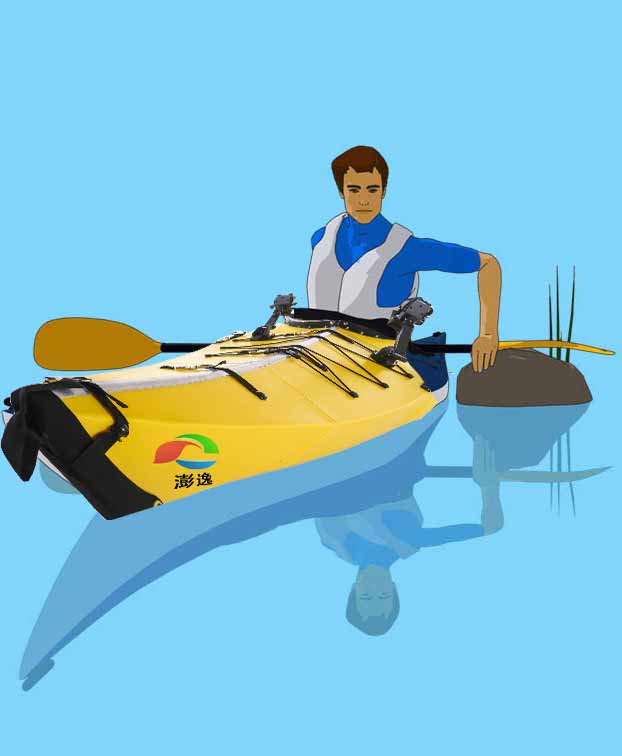 Find something that you can use as a support. For example a rock popping out of the water. First place the kayak between your legs so that the seat is right below you. 找一些你可以用作支持的东西。例如,一块岩石从水中冒出。首先把皮划艇放在两腿之间,让皮划艇的座位正好在你的两腿之间。  Place the paddle right behind the cockpit coaming and lean the other end against the rock. Take a firm hold from the back of the cockpit coaming so that the paddle is stuckt between your thumb and the coaming. Use your other hand to keep the paddle fixed to the rock. Now you have a fairly steady support, but be careful not to put too much pressure on the paddle as it might break. 把船桨放在皮划艇的座舱后面,船桨另一端的叶片放在石头上。用手抓住船桨和座舱圈。船桨用大拇指扣住和座舱圈保持一体。用另一只手压住船桨固定在石头上。这样就会有一个很稳定的支撑。不过要注意不要给船桨施加太大的力,施加太大的力可能会给船桨折断。 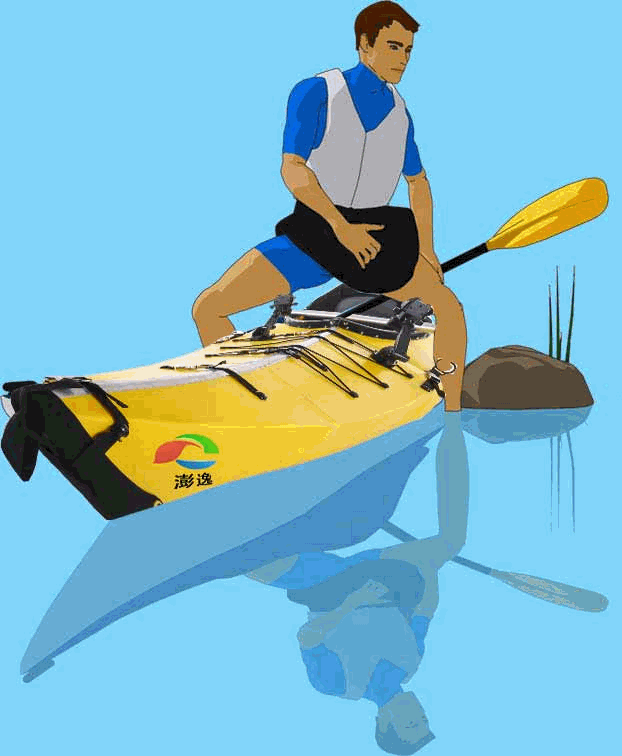 Sit carefully over the coaming, but keep your weight still mainly on your feet. 整个人做下来到座舱上,但是要保持你的体重中心仍然主要在你的脚上。 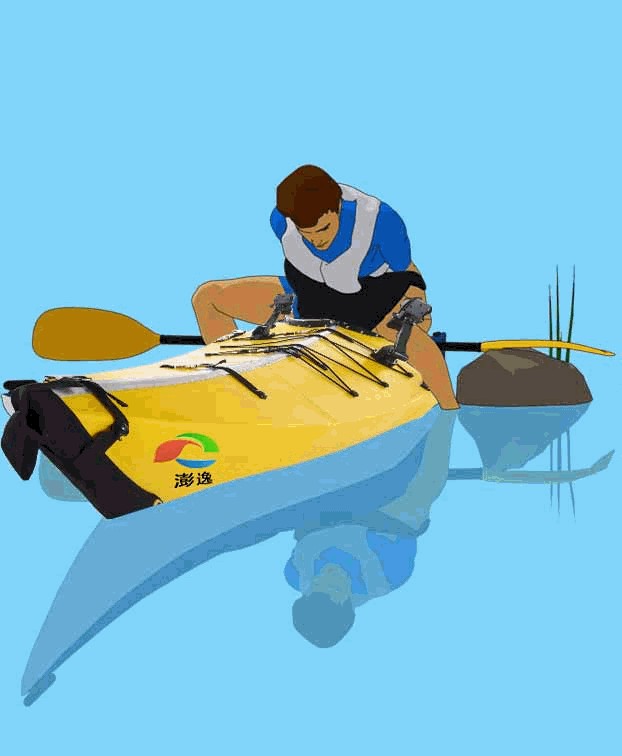 Move your balance slightly to the foot and hand on the supported side and lift your other foot inside the cockpit. Then sit in and raise also your other foot inside the cockpit. Remember to keep your balance slightly on the supported side until you are sitting properly. 将你的平衡点稍稍移到脚上,手放在支撑的一侧,抬起另一只脚在驾驶舱内。然后坐起来,把你的另一只脚放进驾驶舱里。记住在支撑的一侧保持平衡,直到你正确地坐着。 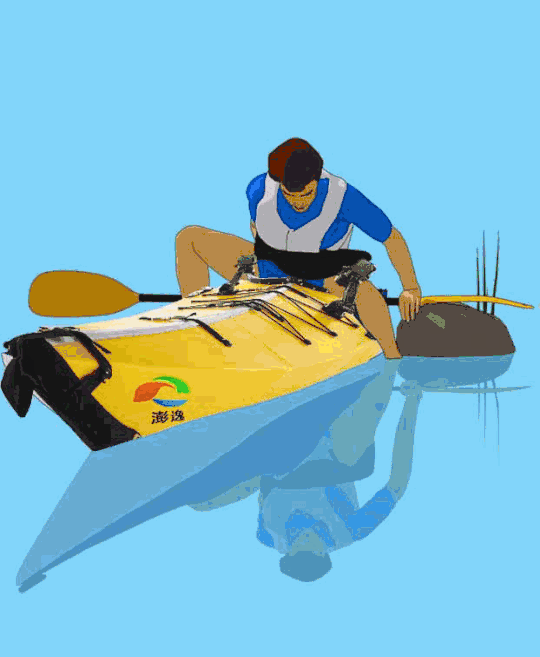  完整的在岸边上艇的动画演示 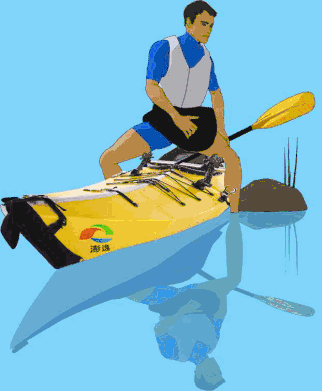 Getting out of the kayak is done in the same way but in opposite order. 离开皮艇是以同样的方式,但以相反的顺序。 想要上岸,需要先找到合适的登录的地点。水面平静,深度适宜的,可以靠近岸边或者凸起的石头。特别注意深度不要太深的水。用船桨支撑在岸边。一只手压住伸向石头的船桨,另一只手抓住船桨和座舱圈固定住船桨。身体向岸边倾斜,重心移动到压住船桨的手臂,保持一个稳定的结构。抬起另外一侧的一只脚出仓。 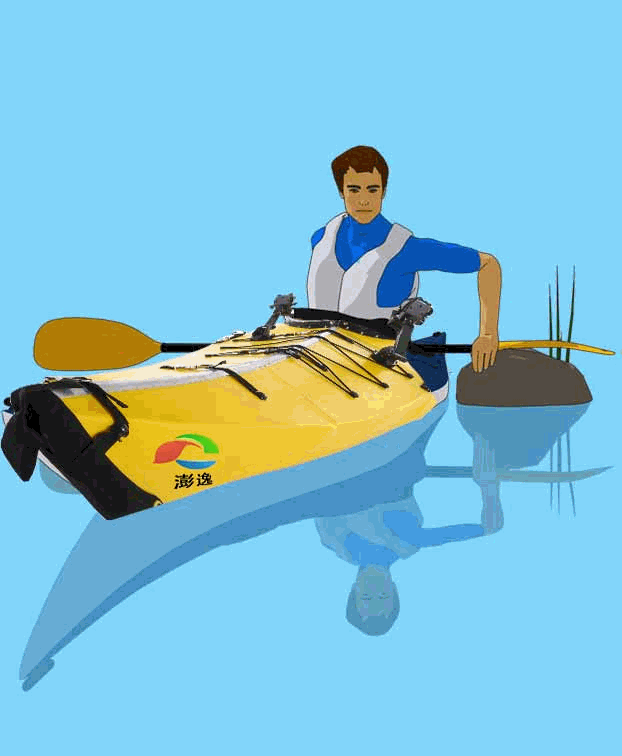 移动重心后,靠近岸边的脚移动出船舱,人做在船舱上。   双脚着陆,坐在皮划艇座舱上面。平衡后,人站立起来离开皮划艇。 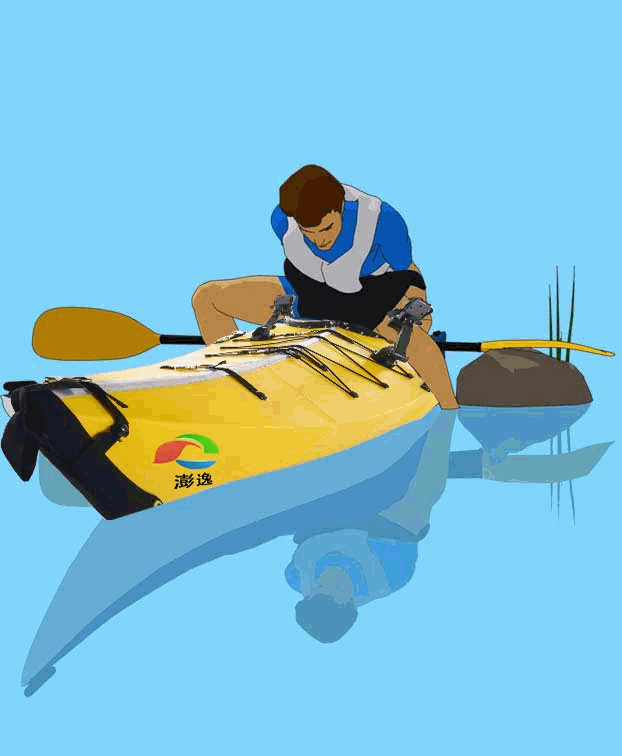 完整的在岸边上艇的动画演示 完整的下艇动画  TIP: – Sometimes there are no rocks nearby so you have to improvise. One way is to ask your friend to hold your kayak still or use your paddle to get support from the bottom. 提示: -有时候附近没有石头,所以你必须临时凑合。一种方法是让你的朋友保持你的皮艇仍然或使用你的桨从底部得到支持。 |
 2017-09-12 19:41:41 2017-09-12 19:41:41
|
Post #6
Re: 皮划艇基础教程-澎逸动画演示版 (第一节 码头上艇) |
 shusheng_100 shusheng_100
|
皮划艇基础教程-澎逸动画演示版 (第三节 保持平衡) 先声明一下,这个是国外网站的,www.kayakpaddling.net 整理了中文,同时制作了gif动画。 皮划艇运动是国内才兴起的一项运动。是一项新兴起的运动,也是一项古老的运动。在国外蓬勃发展。国内也是渐渐兴起。对于皮划艇的基础知识的普及信息非常少。基于此澎逸收集整理制作了一系列教程。希望可以通过这个让大家更好的掌握皮划艇的技术技巧,享受皮划艇运动的健康快乐。 ----澎逸吴树升(欢迎 转载 注明出处) 保持平衡 Keeping balance 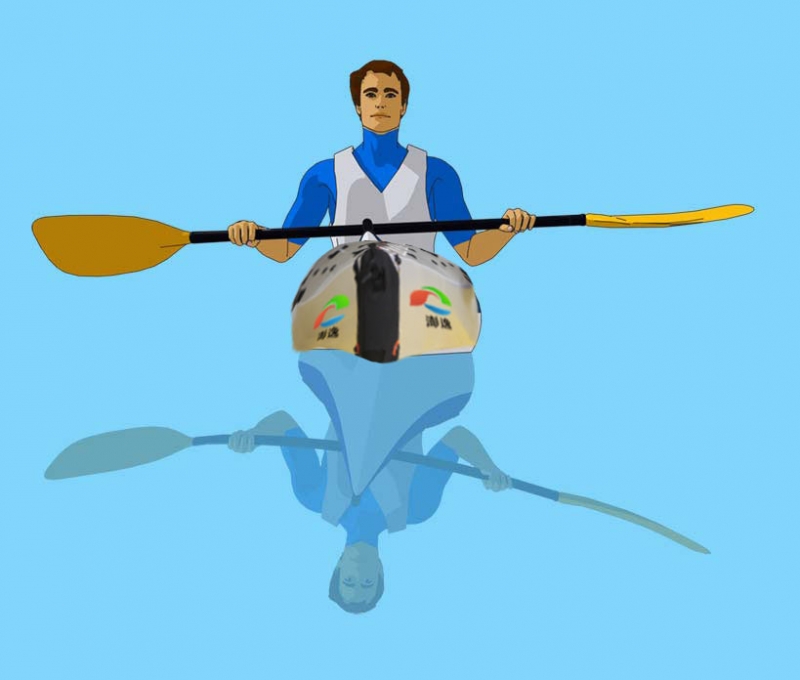 皮划艇的船体宽度比较窄,在水上速度比较快,这样我们在皮划艇上就需要积极的保持平衡。很好的是,这个技术在皮划艇上是非常容易的。而且是非常自然的。 Kayaks are made narrow so that they move easily on the water. This means that you need to actively keep the balance. Fortunately the technique is is easy and usually comes naturally. 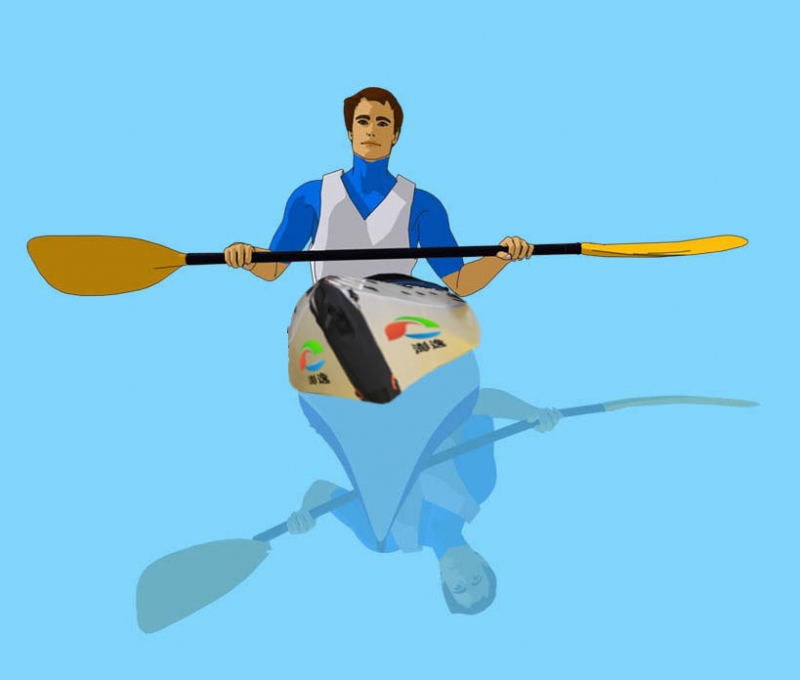 为了保持平衡,你需要保持上身挺直。只要放松你的肚子和腰部,让皮艇倾斜时候或者海浪推动的时候,用腰部的力量自然复位保持平衡。保持你的视野在地平线上也将有助于保持平衡。不要抓住皮划艇。这样可能你自己感觉好,但是不会给你额外的支撑。(优雅的放松) To stay in balance, you need to try keep your upper body upright. Just relax your stomach and lower back and let the kayak tilt freely when the waves push it. Keeping your eyes on the horizon will also help to keep the balance. Don't hold on the kayak. It will tip you over rather than give you any extra support. 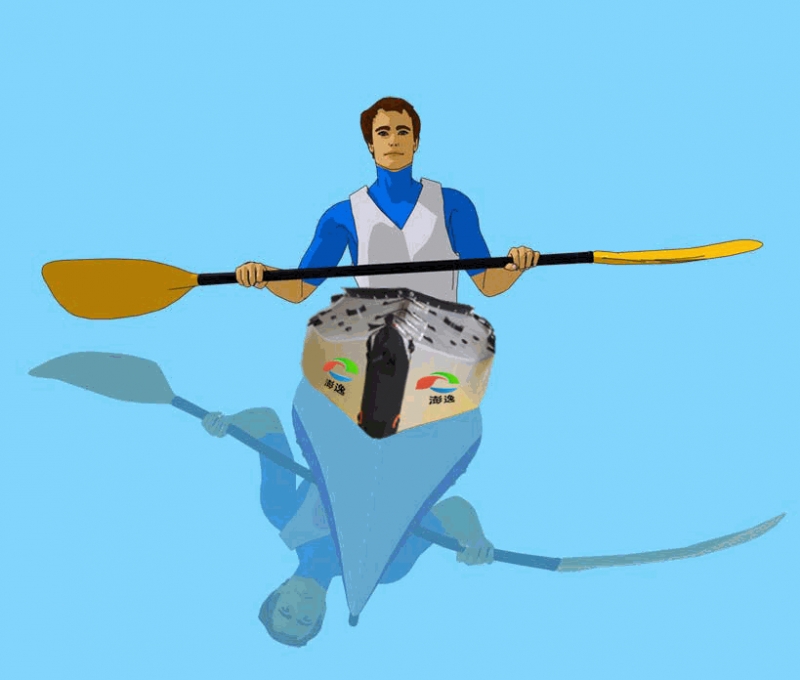 如果你某处失去平衡,需要得到支撑,你只需要用你的船桨叶片背面快速拍打水面。这样会给你一秒钟相当好的支撑,你可以用这个力量立即恢复平衡。 这个皮划艇的支撑技术还有很多的不同的样式,会在爱斯基摩翻滚部分中有详细的讲解。在开始知道这个已经够用了。 If you loose balance and need to get support from somewhere, just quickly slap the surface of water with the back face of your paddle blade. This technique will give a fairly good support for a second, so you also need to recover your balance immediately. This and some other techniques to get support from the water surface are described in detail later on the Braces and eskimo roll section. 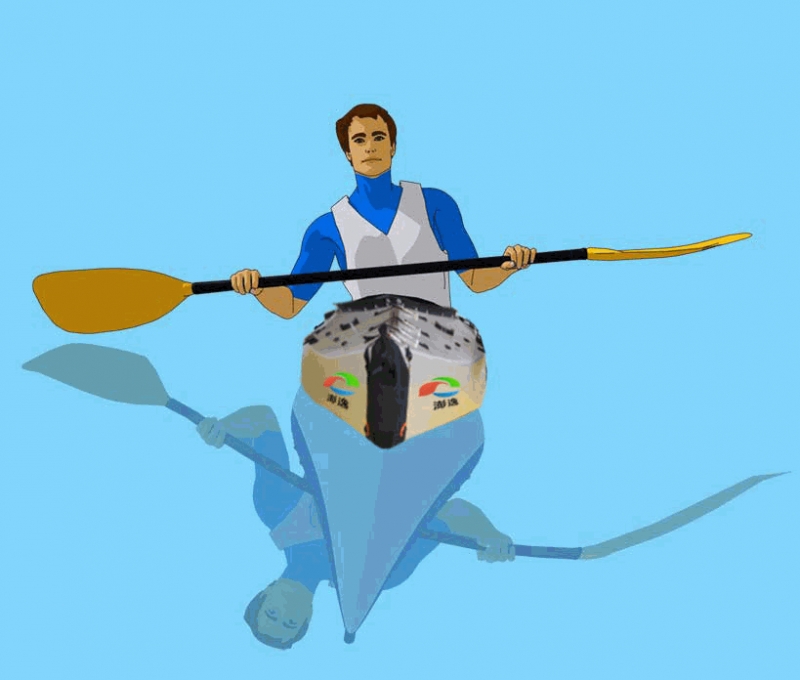 完整的平衡保持动画 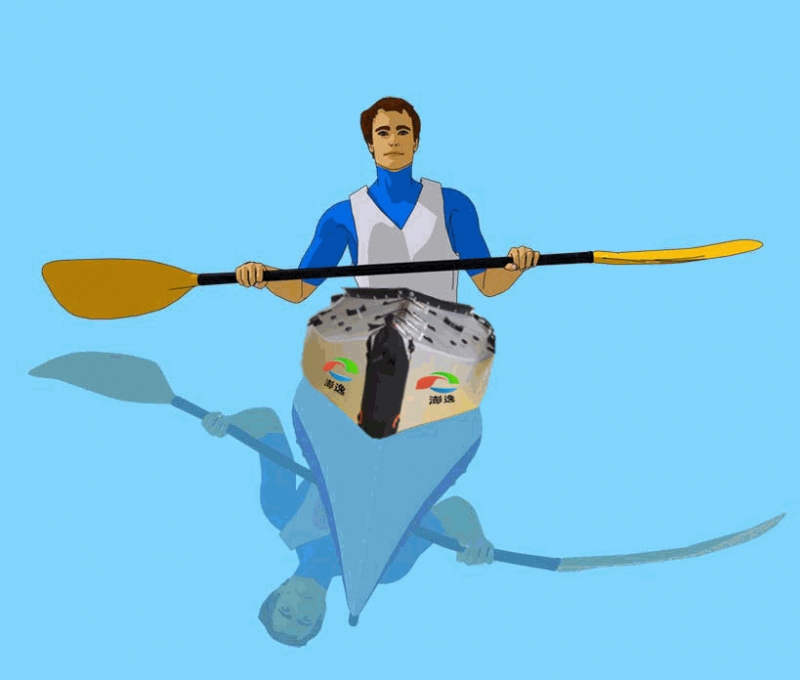
|
 2017-09-12 19:42:38 2017-09-12 19:42:38
|
Post #7
Re: 皮划艇基础教程-澎逸动画演示版 (第一节 码头上艇) |
 shusheng_100 shusheng_100
|
皮划艇基础教程-澎逸动画演示版 (第四课 如何用桨) 先声明一下,这个是国外网站的,www.kayakpaddling.net 整理了中文,同时制作了gif动画。 皮划艇运动是国内才兴起的一项运动。是一项新兴起的运动,也是一项古老的运动。在国外蓬勃发展。国内也是渐渐兴起。对于皮划艇的基础知识的普及信息非常少。基于此澎逸收集整理制作了一系列教程。希望可以通过这个让大家更好的掌握皮划艇的技术技巧,享受皮划艇运动的健康快乐。 ----澎逸吴树升(欢迎 转载 注明出处) How to hold the paddle 如何划桨 Before we start paddling, we need to learn the correct technique to hold the paddle. Although this might sound obvious, there are some tricks worth knowing. 在划船前,需要了解船桨的工作原理,合适的握法。虽然看似容易,但有不少值得留意的小技巧。  When you swim, you bend your fingers slightly into to the form of a cup. Most kayak paddles do the same with their blades. The cup of the blade is called the power face, since it creates the power that moves the kayak. The back of the blade, is called the back face. 比如,您在游泳的时候,划水的手掌会形成一个凹形,一些标准的桨,例如Europaddles,它们的桨面也是有弧度的。内凹的一面称为施力面,因为这一面产生推进舟体的动力。另一面就叫做背面。 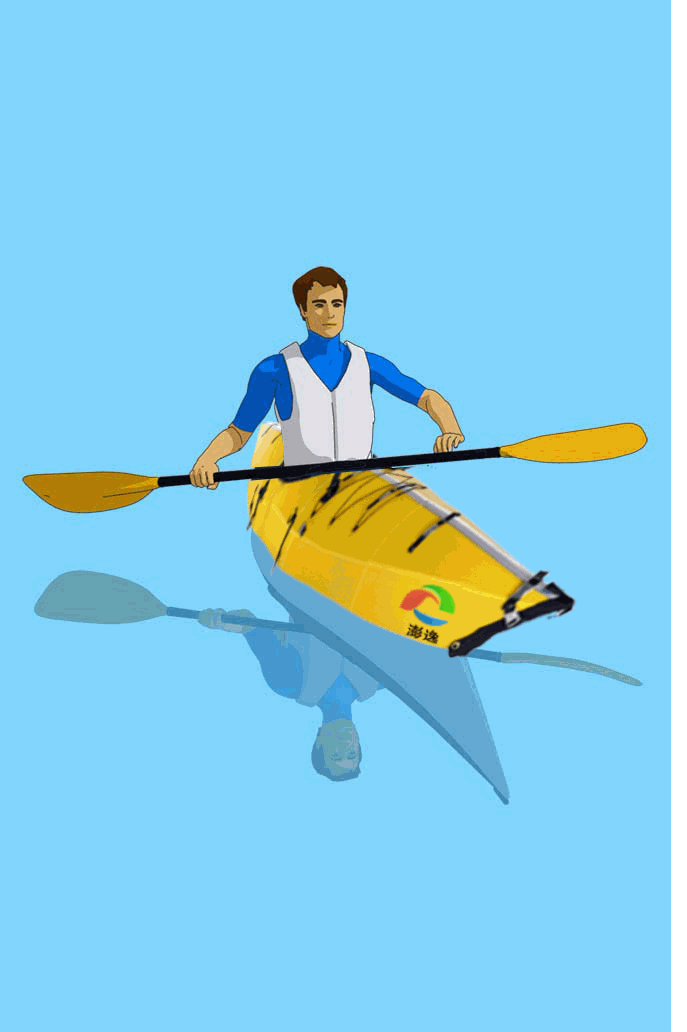 Most paddle blades are slightly asymmetrical, meaning that the upper edge of the blade is longer that the lower edge. To ensure that your paddle travels smoothly through the water, make sure that you are not holding your paddle upsidedown. 大多数的船桨桨面稍微有些不对称,以帮助船桨在水下更平滑地运动,所以不要拿反船桨。 正确的是短刃是在下面的。长刃是在上面。 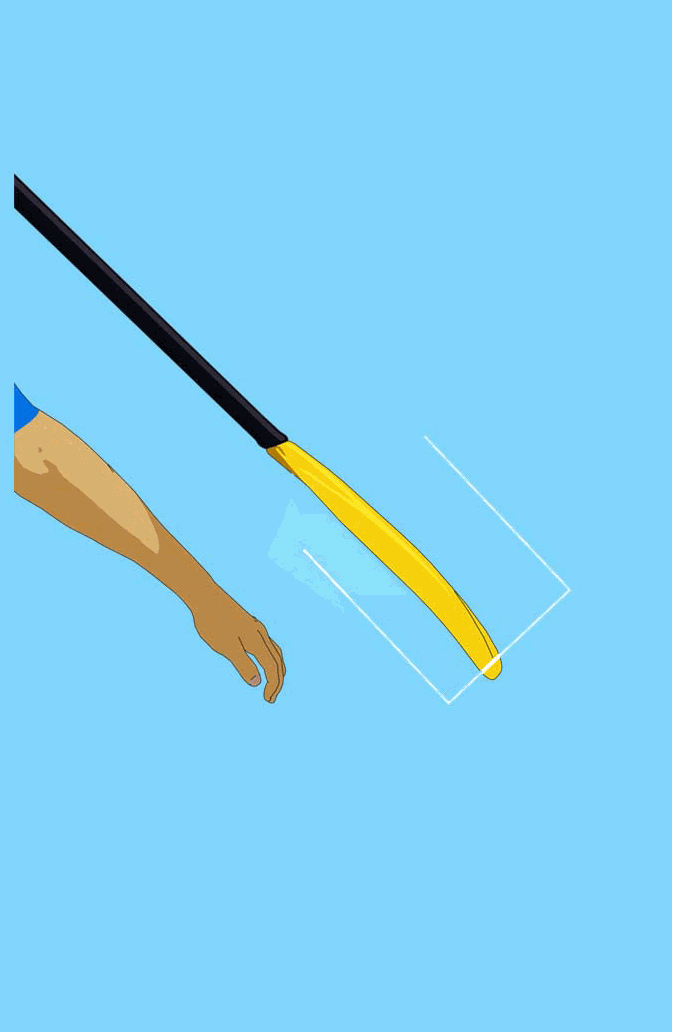 Recommended grip width is roughly the distance between your elbows or a little less. While paddling, it's usually a good idea to change your grip width every now and then so that the workload is spread evenly amongst your muscles. Wide grip gives you more power and control. Narrow grip is usually more pleasant for long distance paddling. 推荐的两手握桨间距大致和两肘距离相同,或稍小一些。在划船时,可以自由调整该间距,以便于更好地在各个肌肉上分配负载。如果需要更大的划船力量或控制力,可以稍微增大间距,相反,如果长途滑行,可以适度缩小。(双手对称握住船桨,让船桨的抓水面正对着自己,举起来船桨顶在头顶后,手臂的小臂和大臂的角度约30度就是我们肘部的距离,也是合乎科学的抓桨的距离。) 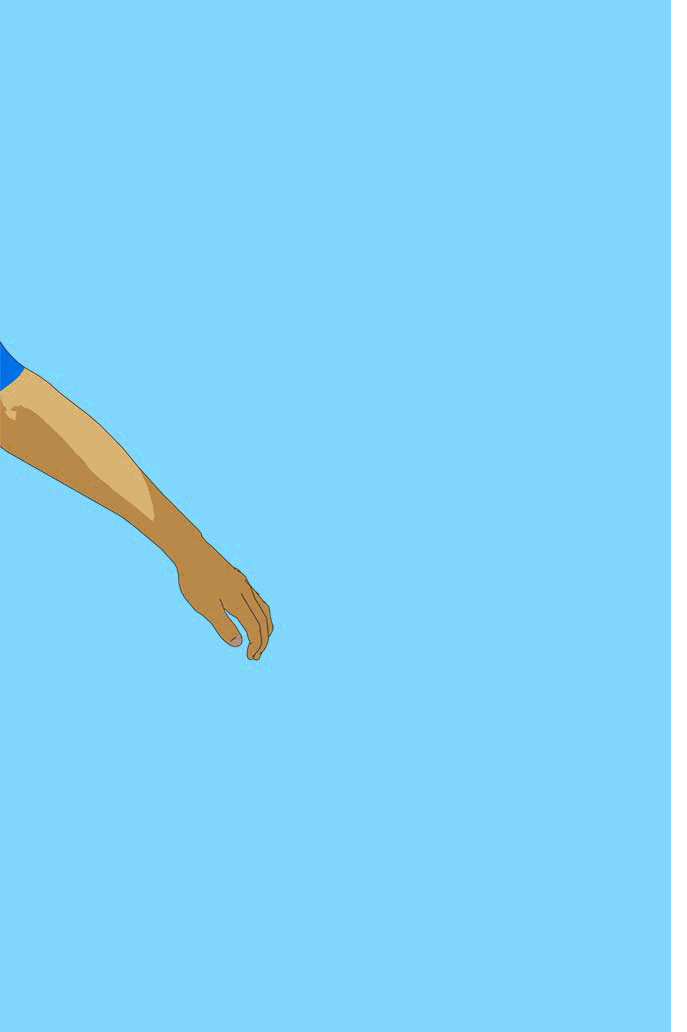 Typically a touring paddle' blades are feathered, meaning that the blades point to different directions. A bit like the blades of an airplane propeller. This helps reduce the air resistance of the raised blade. Paddles can be feathered for left- and right-handed paddlers. Unless you plan to kayak with only your own paddle, try to learn to use a right-handed feather, as left-handed paddles are not commonly found at rental shops and outfitters. The following instructions are for right hand feathered paddles. 典型的旅行舟桨片有一个角度差,像飞机的螺旋桨,这样有利于减小风对水面之上桨片的阻力。一只桨有左手桨和右手桨之分,左手桨为左撇子设计,较少见,后文主要针对右手桨。  Your right hand is your control hand. This means that your grip is fixed and does not change during the strokes. You can control the angle of the blade by your right hand. Don't hold the paddle too tight, otherwise your hands will quickly tire. 右手桨:您的右手是控制手,这意味着,该手握桨处是固定的,而且在划桨过程中不改变。控制手用来调整桨面的运动角度。不要过于用力地抓着船桨,不然容易疲劳。  Your left hand should grasp the paddle shaft loosely, to allow your right hand to twist the paddle to desired angles for turning, bracing and rolling. The "right hand fixed, left hand loose" technique is ideal for a wide variety of strokes, recoveries and manoeuvers. 您的左手松握桨杆,让右手来调整桨的角度,用来划水、击水借力和翻船后的翻滚复位。“右手紧,左手松”是个比较理想的方式,适用于不同类型的划水、复位和转向动作。 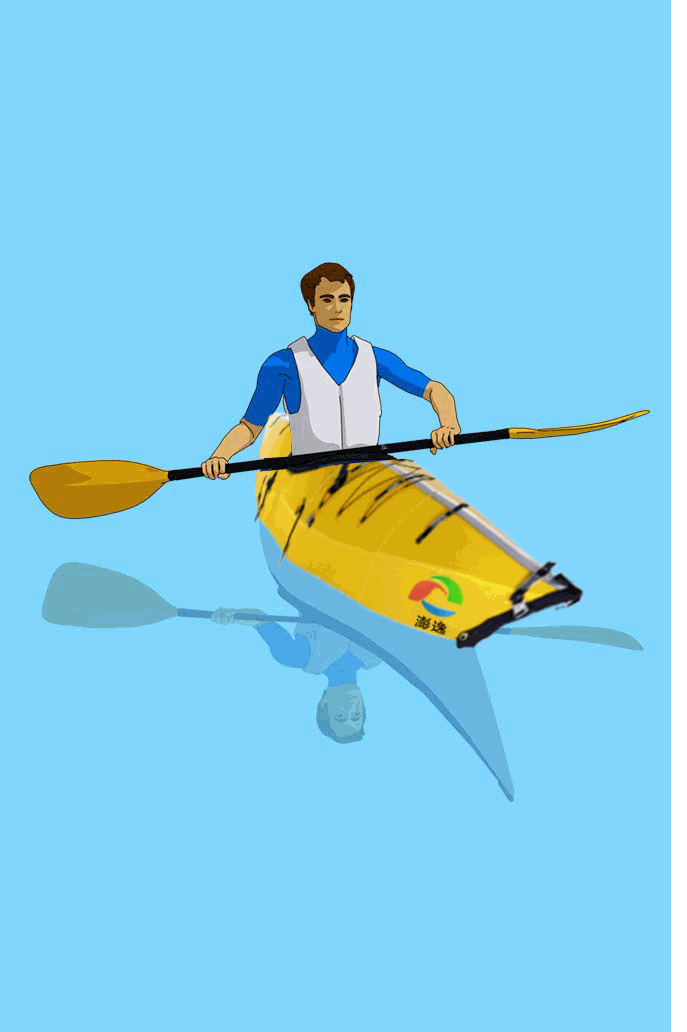 |
 2017-09-12 19:43:27 2017-09-12 19:43:27
|
Post #8
Re: 皮划艇基础教程-澎逸动画演示版 (第一节 码头上艇) |
 shusheng_100 shusheng_100
|
皮划艇基础教程-澎逸动画演示版 (第五课 正向用桨) 先声明一下,这个是国外网站的,www.kayakpaddling.net 整理了中文,同时制作了gif动画。 皮划艇运动是国内才兴起的一项运动。是一项新兴起的运动,也是一项古老的运动。在国外蓬勃发展。国内也是渐渐兴起。对于皮划艇的基础知识的普及信息非常少。基于此澎逸收集整理制作了一系列教程。希望可以通过这个让大家更好的掌握皮划艇的技术技巧,享受皮划艇运动的健康快乐。 ----澎逸吴树升(欢迎 转载 注明出处) Good kayak paddling technique 正向用桨 学习如何让皮划艇前进是很容易的。但是锻炼技术可以确保你的划水速度更快,效率更高,身体承受的压力更小。接下去是一些基本的正向用桨技术。但请注意,适合您的用桨方式需要结合您的身体条件以及桨的类型。在划皮划艇前一定要正确地握住你的桨。 Learning how to paddle a kayak forward is easy. But focusing on a proper technique ensures you can paddle faster, more efficiently and with less strain on your body. Here are the primary elements of a good forward stroke. But keep in mind that the ideal paddling technique depends also on your physical condition and the style of your paddle. Be sure you are holding your paddle correctly before proceeding.  好的姿势是问题的关键,这样您能更有效地运动您的全身。坐正,放松肩部,展胸利于高效的呼吸,不要靠着靠背。 Good posture is key if you are to use your body efficiently. Sit straight, relax your shoulders, and open your chest for ease and efficiency of breathing. Don't lean against the backrest. 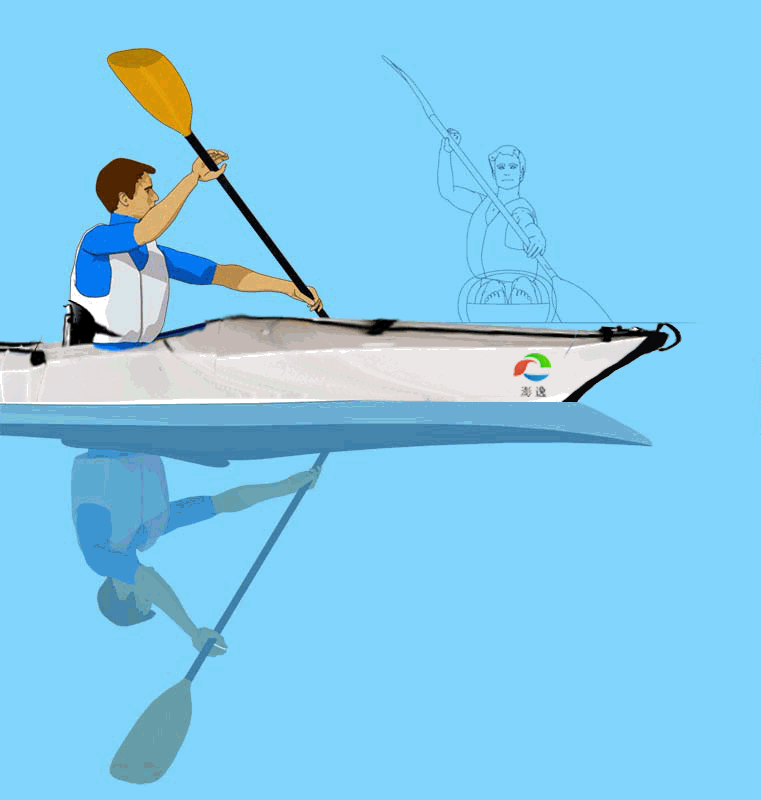 并拢双腿,把脚抵紧脚蹬。出发前需要调整好脚蹬的位置,让膝盖稍微弯曲,这个姿势能在必要时施力于船舱内侧提供额外的平衡。并拢双腿能更好地保证躯干的转动,来高效地划船。重要的一点是:身体躯干和双腿在划船时起了绝大部分的作用,您的肩部和双臂只是起了传递力量的作用。 Keep your legs together with feet against the footpegs. Adjust the footpegs so that your knees are bent slightly and you are able spread and press them against the kayak for extra balance if needed. Keeping your legs together allows better torso rotation and makes paddling more efficient. Be sure that you have proper footpegs you can push against. 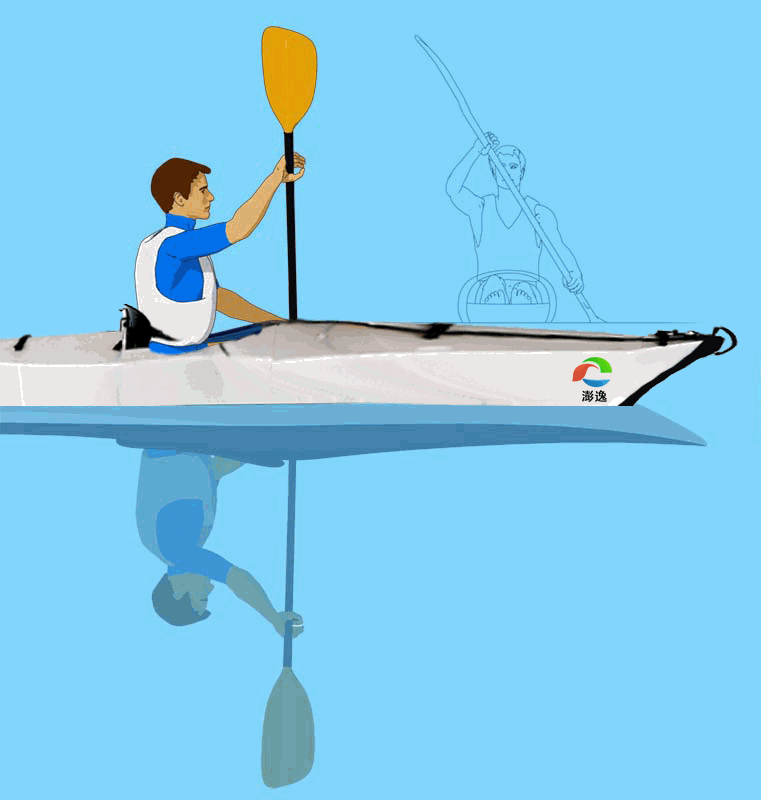 身体躯干和双腿在划船时起了绝大部分的作用,您的肩部和双臂只是起了传递力量的作用。在学习体会这个原理时,可以先保持双臂笔直,只用身躯转动来划船。在划船时,可以想象您正在把自己相对于桨,向前向后抬拉(pulling)。 Your torso and legs will do most most of the work. Your shoulders and arms are only there to transmit power. To learn the principle, try paddling by rotating your torso and keep your arms absolutely straight. When you place the blade in the water, imagine your are pulling yourself up to and past the paddle. 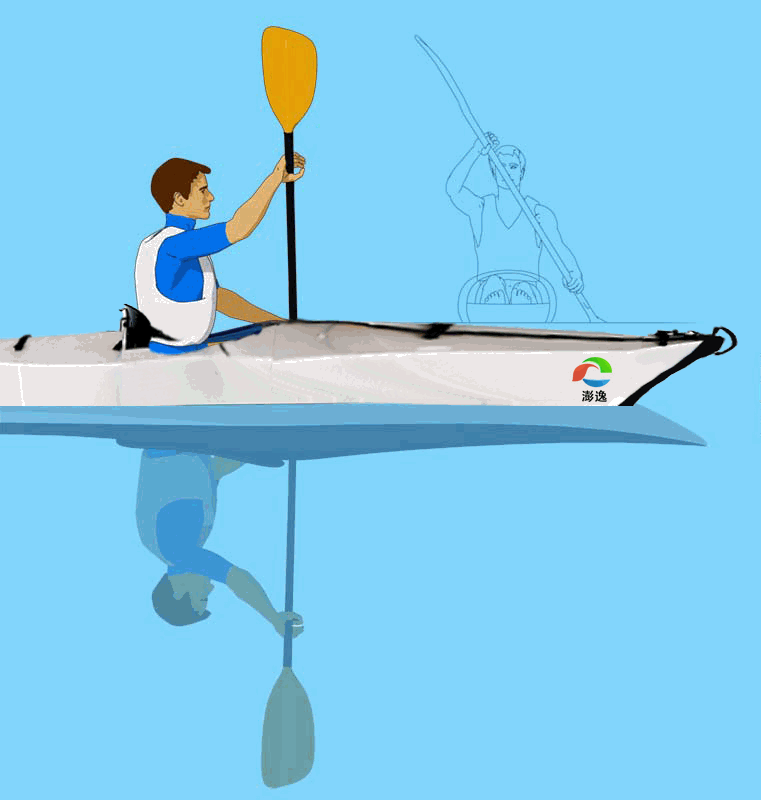 刚开始划水时,扭转身形,这时船桨在您脚旁逼近船的吃水线位置。在下方的手臂几乎伸直,在上方的手臂弯曲放松,手腕靠近下巴。划水一边的脚踩紧脚蹬,船桨入水时有类似矛刺戳的动作。 At the start of your stroke, coil your torso so that you place the blade in the water up by your feet and close to the kayak's waterline. Keep your lower arm almost straight. Relax your upper arm with a slight bend so that your upper wrist comes a bit closer to your eyes. Press your stroke-side foot firmly against the footpeg. Sink the blade into the water with a spearing motion.  恢复扭转的身形,开始划水,并保持在下位的手臂近直,划水一边的脚踩紧脚蹬提供助力,在划水的前阶段施加较多的力量,而在结束阶段施加较少的力量。这是因为在桨刚入水时,桨手躯干部位的主要肌肉有很好的角度,能较轻松产生较大的力量。 让您上位的手臂放松,松松地把持船桨,使得相应肌肉得到休息。上位的手保持在眼睛的水平,让该手在身体旁运动,来保持船桨竖直。 当下位手划到桨手腹部水平时,结束一次划水。如果在更低处结束划水,船桨在水里拖行,会产生阻力,减慢舟速。 Begin the paddling stroke by uncoiling your torso and keeping the lower arm near straight. Keep pressing the stroke-side foot against the footpeg to support the stroke. Try to generate more power at the beginning of the stroke, less at the end. That way you create power with the strong muscles of your torso, and right when your paddle is in the water at its most favourable angle. Keep your upper arm relaxed and hold the paddle loosely, so your muscles can rest. Keep your upper hand at about eye level, and allow your upper hand to move across your body, to keep the paddle vertical. End the stroke when your lower hand is about level with your your belly. Continuing further would feel natural, but it just slows you down. 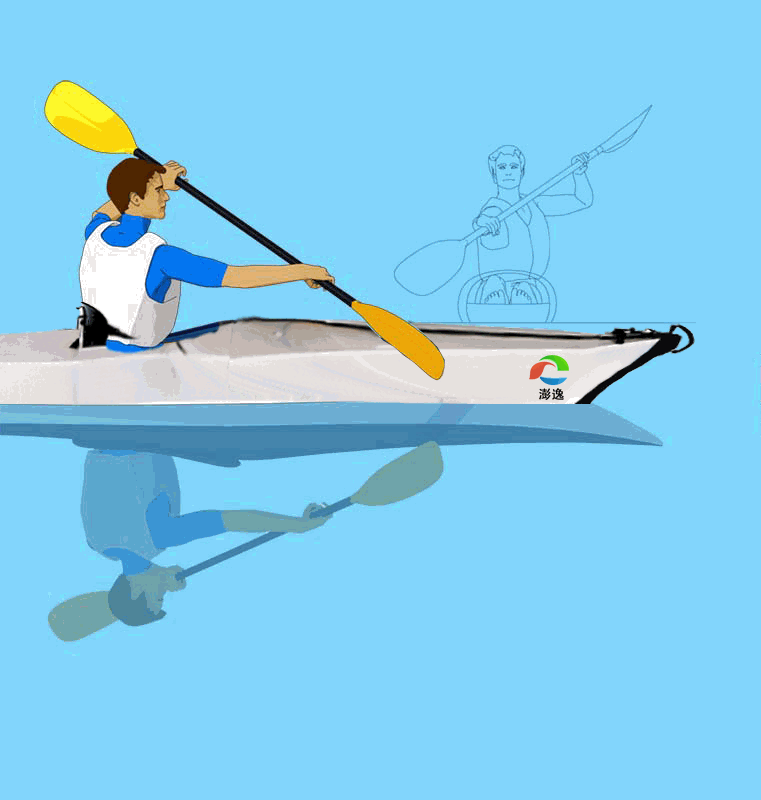 桨叶在舟的后侧远离舟身处出水,用肘带动桨出水,手腕顺从。注意:桨叶出水时相应的肘部不能高于肩部,让您的前臂顺着身躯的转动而运动。 After the stroke, move the blade out of the water to back and away from the kayak. Lift the blade out of the water by leading with the elbow. and allowing the wrist to follow. Take care not to lift your elbow above shoulder level. Let your upper arm follow the rotation of your torso. 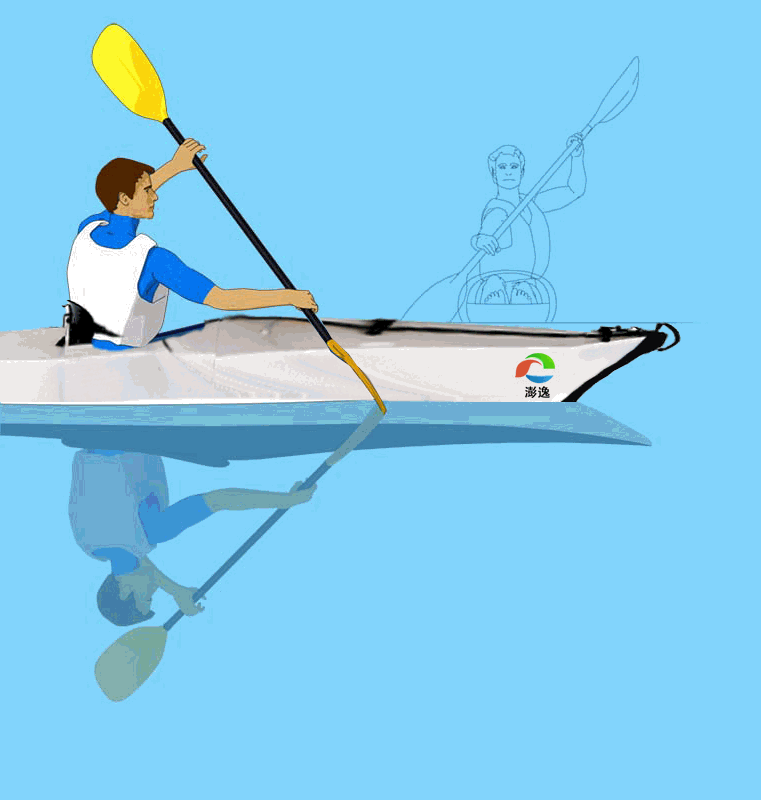 桨叶完全出水后,继续扭转上身,这样能让您尽可能远地准备另一侧的划水。 After you lift the blade from the water, prepare for the next stroke. Keep coiling your upper torso so that you can start the next stroke as far forward as possible. 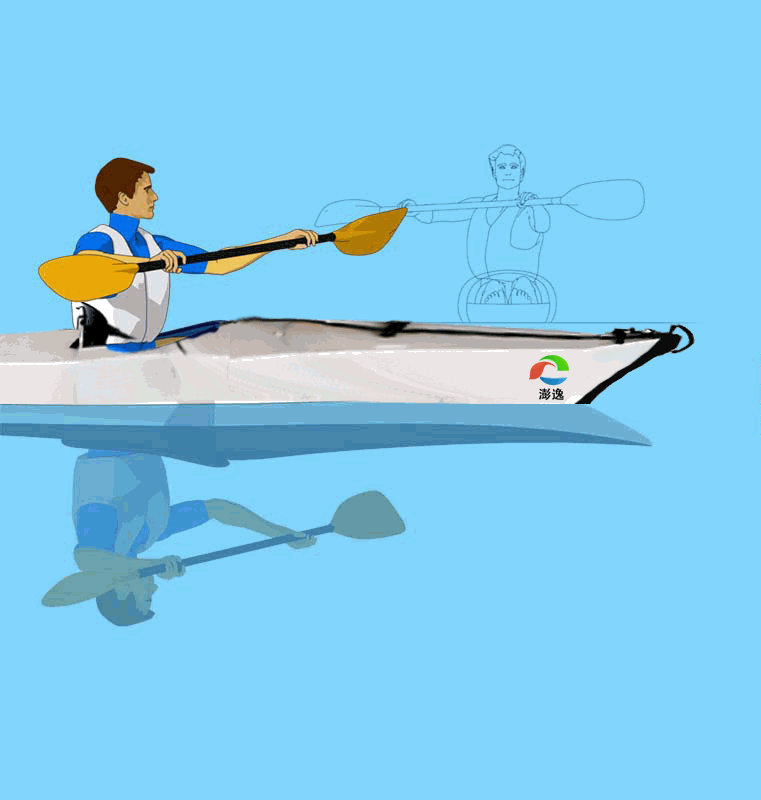 划桨时保持动作流畅,记住正向用桨和在一条直线上划桨是两码事,经常检查下列易犯错误: 1.体姿不正确 2.躯干转动不足 3.每次划桨结束得太慢,出水点相对臀部太后 4.在上位的手伸得太前,导致一个不高效的划桨角度 5.划桨时重心偏移突然,导致舟身左右晃荡 6.手腕用力过度导致弯曲 Try to maintain a continuos flow, but focus on each paddling stroke. Remember that paddling forward is not the same as paddling in a straight line, so keep reading the following tutorials also. COMMON MISTAKES: – poor posture – insufficient torso rotation – ending the stroke too late and too far behind the hip – pushing the upper hand too forward, creating a less effective blade angle – rocking the kayak from side to side with abrupt weight shifts – straining the wrists by allowing them to bend 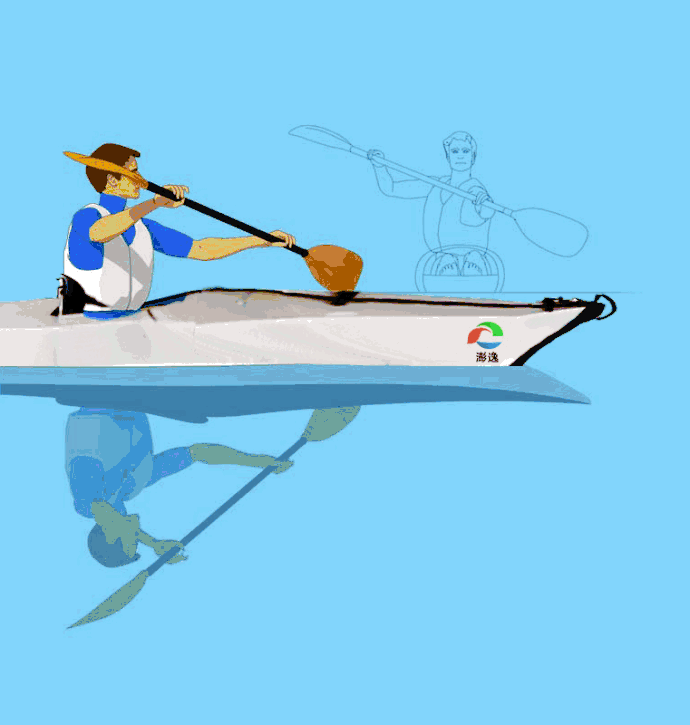
|
 2017-09-12 21:25:41 2017-09-12 21:25:41
|
Post #9
Re: 皮划艇基础教程-澎逸动画演示版 (第一节 码 ... |
 shusheng_100 shusheng_100
|
皮划艇基础教程-澎逸动画演示版 (第六课 桨当后舵) 先声明一下,这个是国外网站的,www.kayakpaddling.net 整理了中文,同时制作了gif动画。 皮划艇运动是国内才兴起的一项运动。是一项新兴起的运动,也是一项古老的运动。在国外蓬勃发展。国内也是渐渐兴起。对于皮划艇的基础知识的普及信息非常少。基于此澎逸收集整理制作了一系列教程。希望可以通过这个让大家更好的掌握皮划艇的技术技巧,享受皮划艇运动的健康快乐。 ----澎逸吴树升(欢迎 转载 注明出处) 桨当后舵 Paddle as stern rudder 有许多不同的方法可让船变向,最“简单”的可以采用一个以脚蹬来控制的船舵。不过这个装置太豪华了,我们需要更实用的办法。在本部分,我们来看看如何使用船桨来达到船尾舵的功效。这是一个非常好的办法,让我们即使在风、浪、洋流影响下,也能保持或快速地改变航向。 There are several methods to make the kayak go to a desired direction. The easiest technique is a built in rudder that is controlled with foot pedals. But you should learn to survive also without such a luxury equipment. On this section we will learn to use the paddle as a stern rudder. It is a quick and powerful way to keep direction or change it rapidly. Stern rudder or stern draw is especially usable when wind, waves or water current tries to overtake control. However, the downsides are that it slows you down and breaks your paddling rhythm. That is the reason why you should not consider the stern rudder your primary method for fine tuning direction. 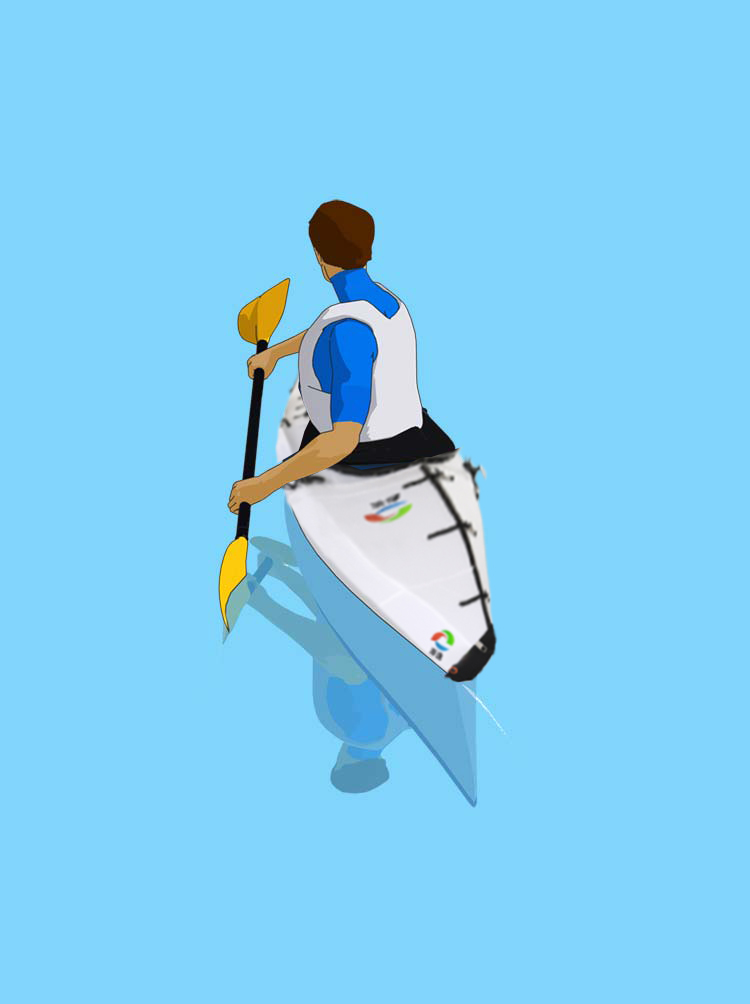 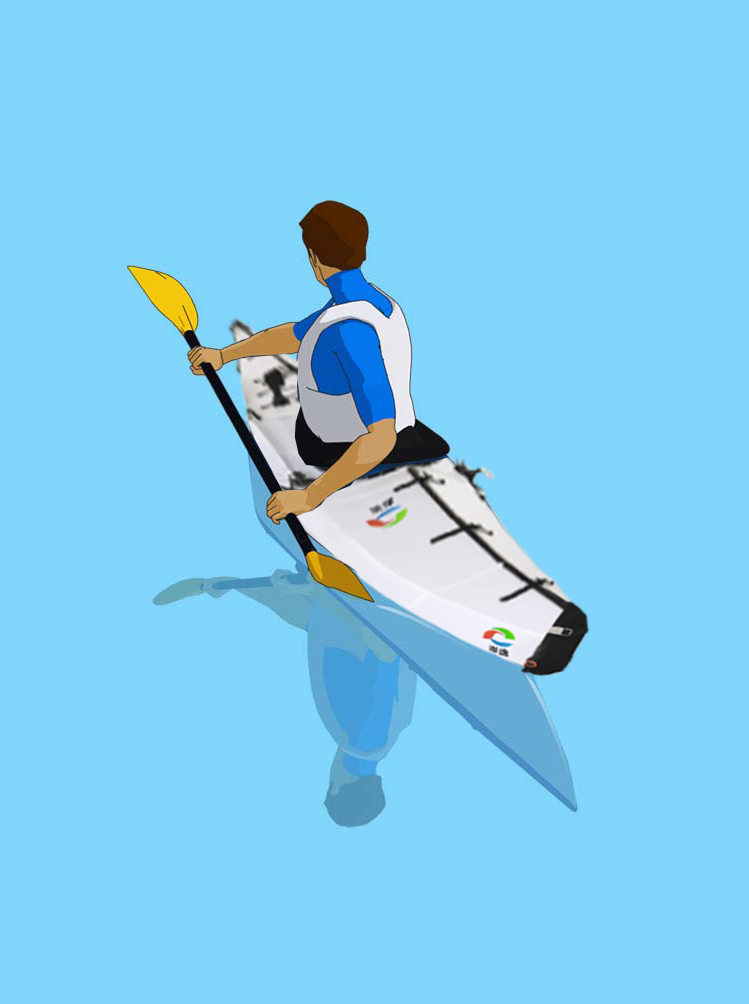 学习这个方法时,先让船正常前行,知道您获得了足够的速度。 To learn how stern rudder is done, you need to have the kayak moving. So for beginning, paddle forward until you gain a good speed.  然后在一次正常的划桨动作中,让桨停留在水中,并继续向后划,知道桨面几乎和船体两两并排。这时,如果您让桨面的上缘外翻稍远离船体,船会向桨所在一侧变向;如果桨面与水面垂直,船将直行;相反,如果桨面上缘贴近船体,船将转向相反的一侧。 After a normal forward stroke, let the paddle stay in water and continue the stroke behind you until the paddle is almost parallel to the kayak. If you keep the upper edge of the blade tilted away from the kayak, the kayak will turn to the side where the paddle is. Keeping the blade in about vertical angle makes the kayak go straight and tilting the blade's upper edge towards the kayak, will make the kayak turn to the opposite side. 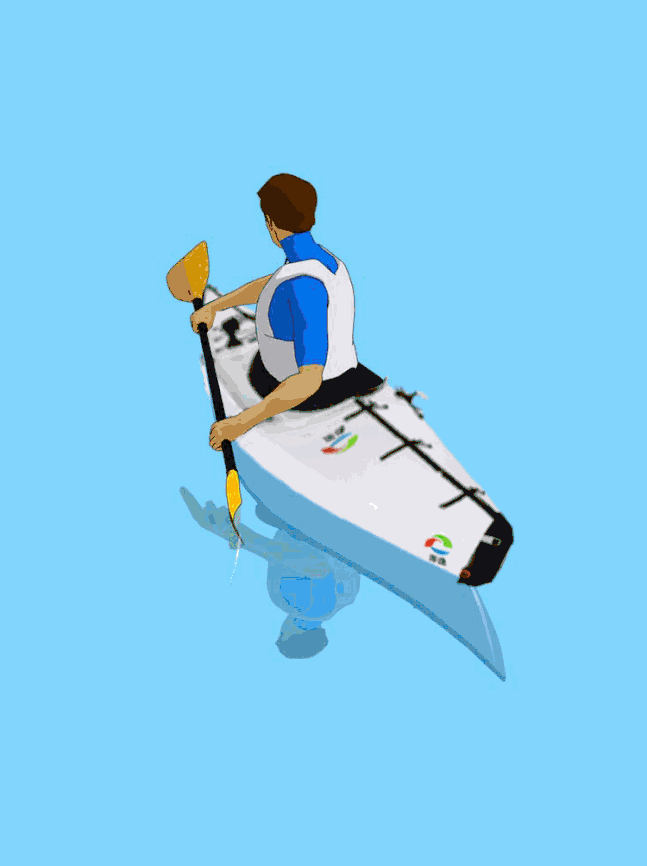  小提示: 把船桨当船尾舵主要用于让船转向,但也可以方便地运用于其他目的。 在船前行时,让桨面水平保持在水中,这样您就可以得到一段时间的支持。这个在您需要向后方看时,尤其有用。 如果想让船减速,把船桨水平按在水中,向前下按即可。 TIPS: – While steering the kayak might be the primary purpose for using stern rudder, it is quite easily transformed for other purposes also. – When the kayak is moving forward, put the blade in horizontal angle, and you can use the stern rudder for getting support for a while. This is useful for example if you need to look behind. – And to use the paddle for slowing down, just keep the blade horizontal and push it down under the water. 完整视频展示 
|
 2017-09-16 20:54:44 2017-09-16 20:54:44
|
Post #10
Re: 皮划艇基础教程-澎逸动画演示版 (第一节 码 ... |
 shusheng_100 shusheng_100
|
皮划艇基础教程-澎逸动画演示版 (第七课 扫桨转向) 皮划艇运动是国内才兴起的一项运动。是一项新兴起的运动,也是一项古老的运动。在国外蓬勃发展。国内也是渐渐兴起。对于皮划艇的基础知识的普及信息非常少。基于此澎逸收集整理制作了一系列教程。希望可以通过这个让大家更好的掌握皮划艇的技术技巧,享受皮划艇运动的健康快乐。 ----澎逸吴树升(欢迎 转载 注明出处) 扫桨转向 Forward and reverse sweep strokes 想让船转向,您看似只需在船体非转向侧用力划水就行了。但实际上,这样只会加快船速,而转向的效果并不明显。我们需要稍微改变一下我们划桨的方式,用扫桨来转向。 相比上节利用船桨的舵功能转向来说,扫桨转向更适合作为我们首选的转向方法,因为它并不减慢船速也不会打乱您的划桨频率。 It might sound quite obvious that to make the kayak turn, you just have to paddle harder on the opposite side. But actually that technique mostly just increases the overall speed and does very little to turn the kayak. We need to modify our forward paddling stroke a bit and do a so called forward sweep. It is a good technique to be your primary steering stroke, because it doesn't slow you down and makes it easy maintain your paddling rhythm. 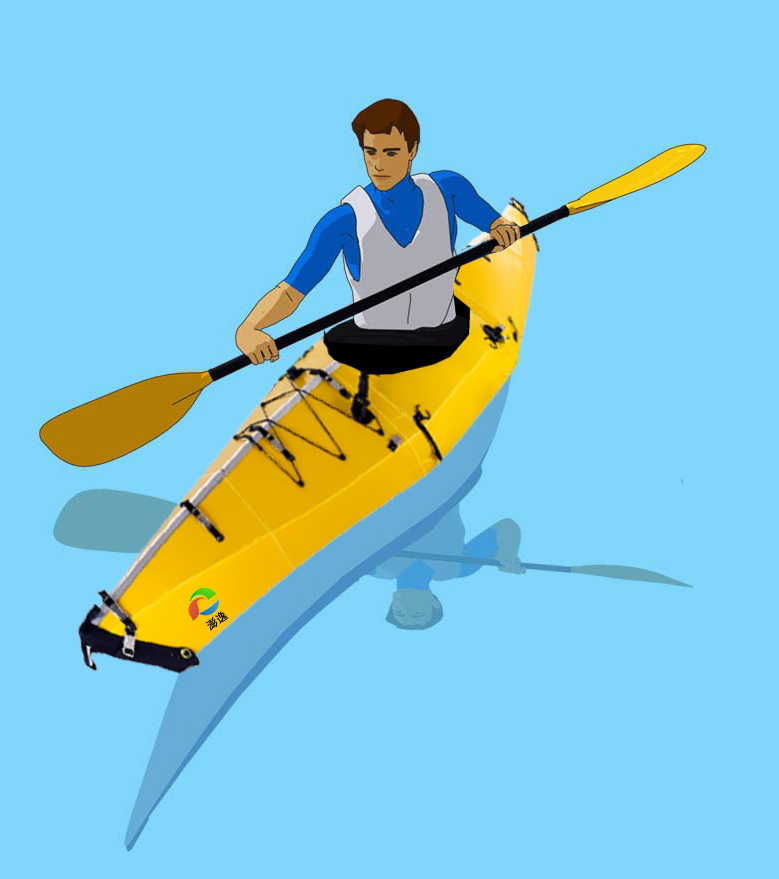 首先,使用正常的前向用桨握桨方式。然后桨叶如水时,尽量向前一些,但不要太勉强(能轻松达到为准),桨面入水时垂直,受力面面向船体外。同时在上位的手也要配合放低。这时,开始让桨在船侧做大圆弧运动,从船首划到船尾。划大圆弧时,用上身体的力量,尽量让两只手保持相对静止 Forward sweep stroke can be done when the kayak is moving, or when it is standing still. First take a regular forward paddling grip from the paddle. Place the blade into the water as forward as you can easily reach and keep the power face of the blade pointed away from the kayak. Keep the other hand fairly low. (这个是一个标准的入水姿势)  下面动画是正向扫桨转向的完整演示  为了使皮艇在其位置上快速旋转,前向划杆的一个很好的补充就是一个反向的划划。这只是向前向后扫,从后面开始,接近你的脚趾。 To make the kayak turn rapidly on its place, a good addition to forward sweep stroke is a reverse sweep stroke. It is just a forward sweep done backwards, starting from the back and ending close to your toes. 下面动画是正向扫桨转向的完整演示 
|
 2017-10-06 14:52:59 2017-10-06 14:52:59
|
Post #11
Re: 皮划艇基础教程-澎逸动画演示版 (第一节 码 ... |
 shusheng_100 shusheng_100
|
皮划艇基础教程-澎逸动画演示版 (第八课 侧倾利刃转向) 皮划艇运动是国内才兴起的一项运动。是一项新兴起的运动,也是一项古老的运动。在国外蓬勃发展。国内也是渐渐兴起。对于皮划艇的基础知识的普及信息非常少。基于此澎逸收集整理制作了一系列教程。希望可以通过这个让大家更好的掌握皮划艇的技术技巧,享受皮划艇运动的健康快乐。 ----澎逸吴树升(欢迎 转载 注明出处) 侧倾利刃转向 Carving turns 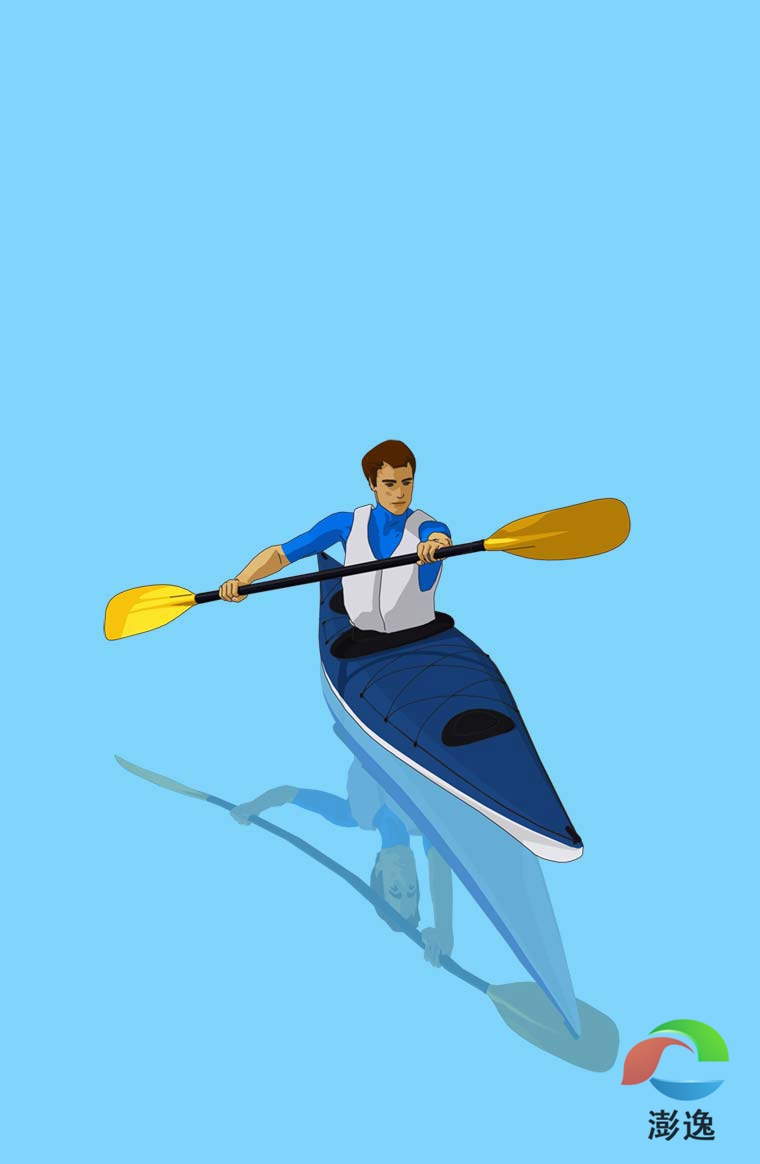 这个是非常重要的一个技术,是一种不影响船的前进速度和桨频的一种转向技术,在竞技上用来控制方向非常好用。 这个主要是叫皮划艇和水面行程一定的角度,这样在水中就可以实现转向的目的。右转向船左倾(右转抬右屁股)左转向船右倾(左转抬左屁股)船体的转向方向和侧倾的方向相反。这个因为船不一样,所以侧倾的角度不同,转向的幅度也不一样。主意腿部膝盖用力和要不用力。 -----澎逸吴树升备注 倾侧船体转向对于其他转向方法来说是很宝贵的转向技术,既可以独立使用,来可以结合其他转向技术一起施为。这个转向技术在天气条件影响较大时(例如,侧风使船来回摇晃时),尤为见效。 Carving turns is a real asset to other turning methods. This technique can be used on its own and to boost other turning methods. Carved turns are especially useful when counteracting weather- or leecocking, or a slight tendency of stern-quarter winds to turn a kayak up- or downwind. Since carved turns require you to edge your kayak, you should practice them on sheltered waters first.  由于需要倾侧船体,学习体会该技术时,应该先在安静的水域中进行。 When the kayak is edged, the curve of the hull is submerged, forcing the kayak to turn to the opposite side of the edging. The amount of edging you'll need varies from kayak to kayak. 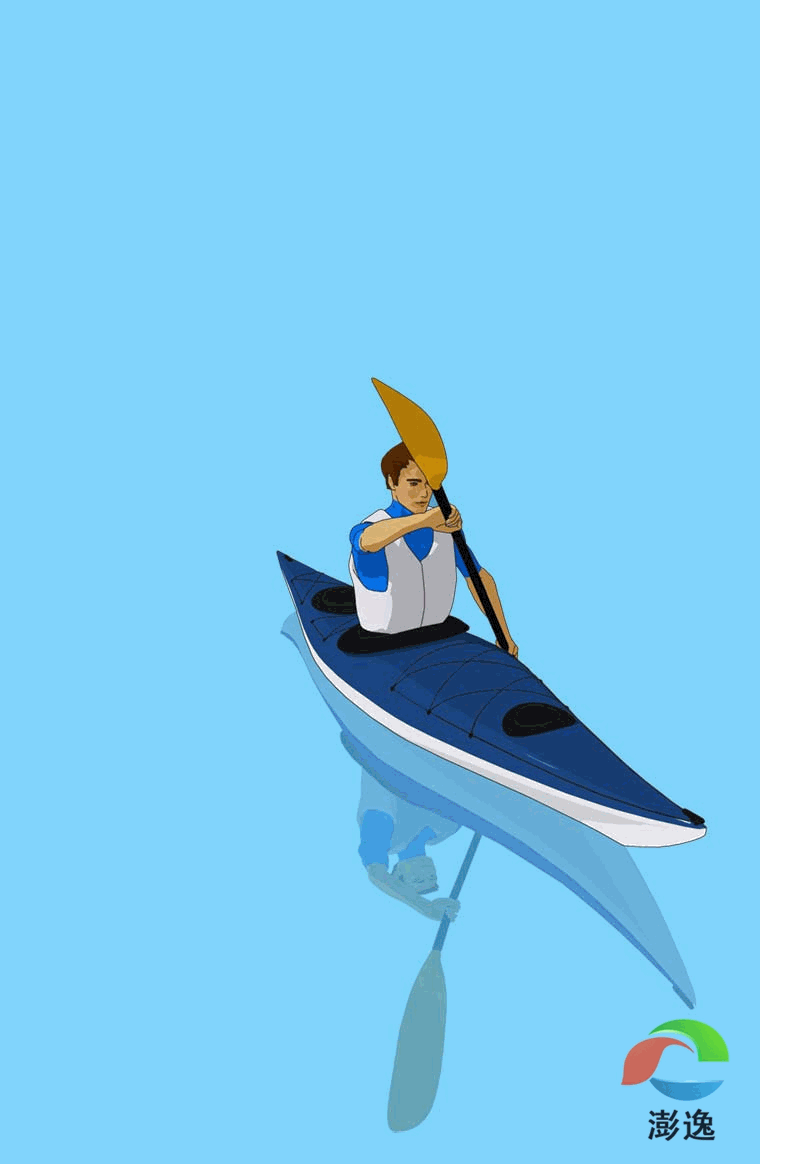 在船底部看侧倾的方式 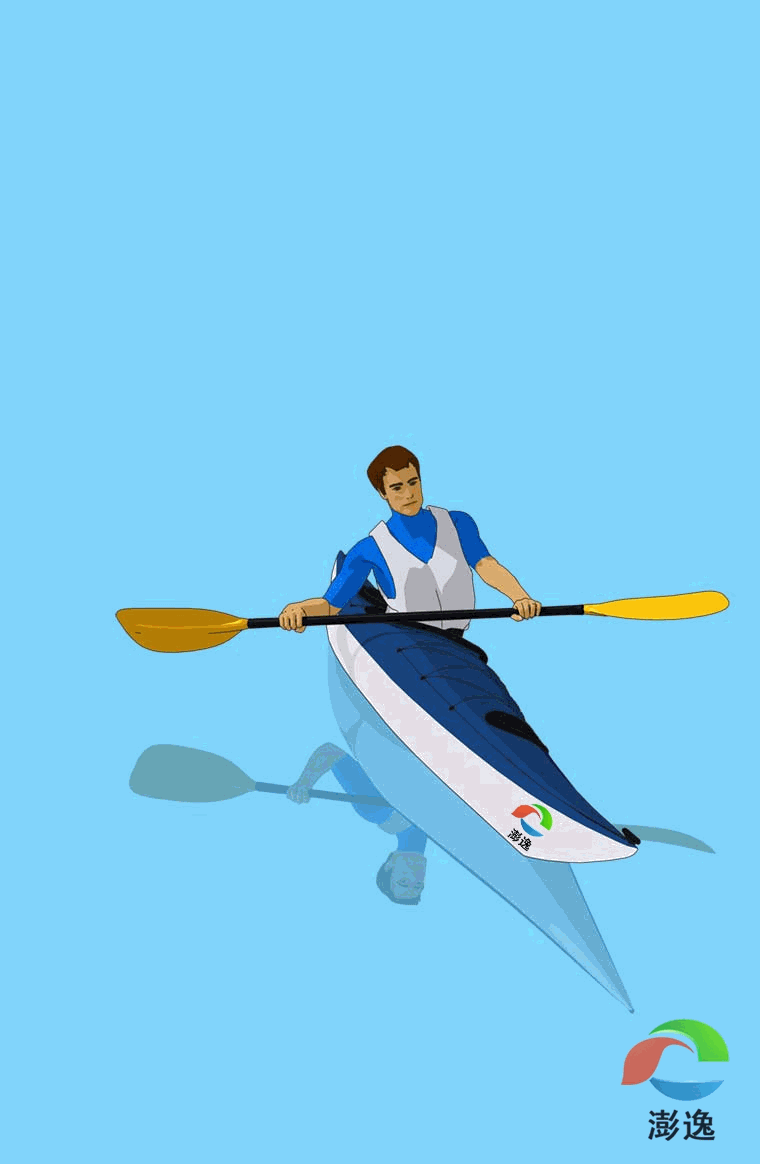 当船体倾侧时,船体相应的一边会没入水中,这迫使船转向倾侧的一方。每条船转向倾侧的程度各有不同。 To make your kayak edge, push one knee up against the underside of the foredeck while simultaneously weighting the opposite hip. 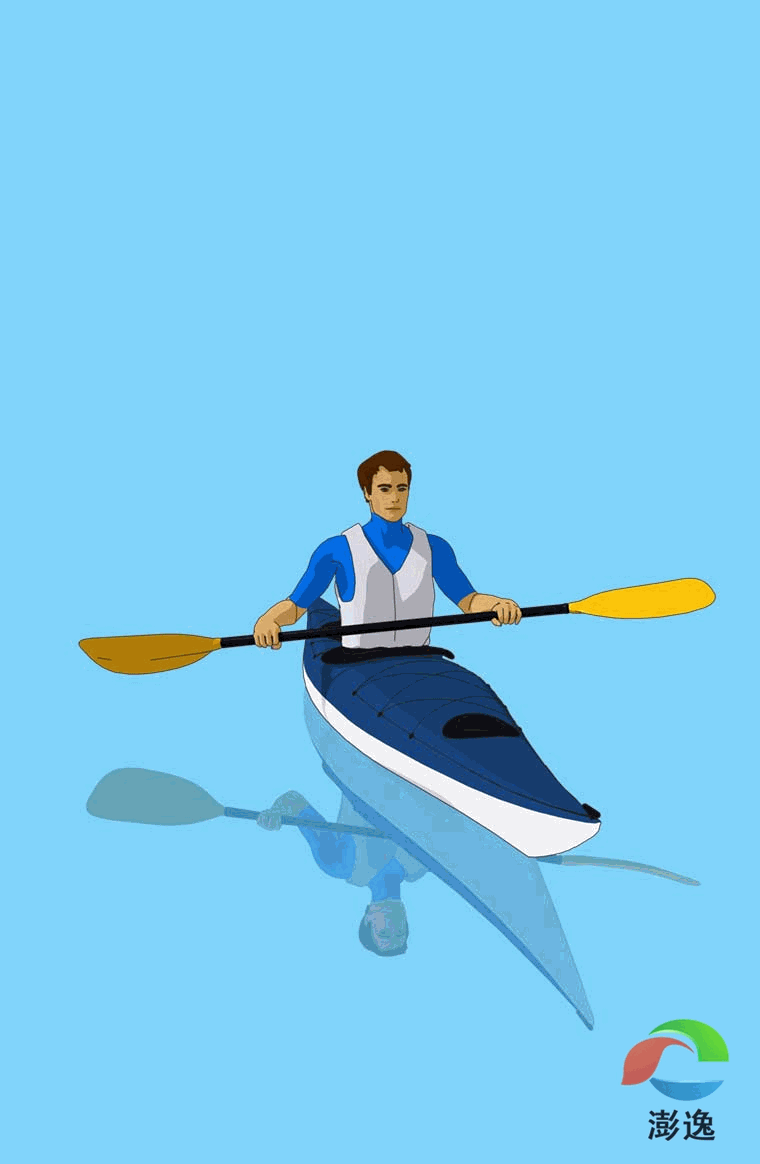 为了让船倾侧,需要使用船舱内的两腿。船体需要抬高的一侧膝盖上顶船体,向下倾侧的一侧大腿及臀部同时下压。练习时,可在您船滑行过程中倾侧船体,尽量长时间的保持船体侧倾。保持视线水平会有助于加强平衡。 Edge the kayak while gliding, and try to hold the edge for as long as you can. To improve your balance, keep your eyes up, towards the horizon. 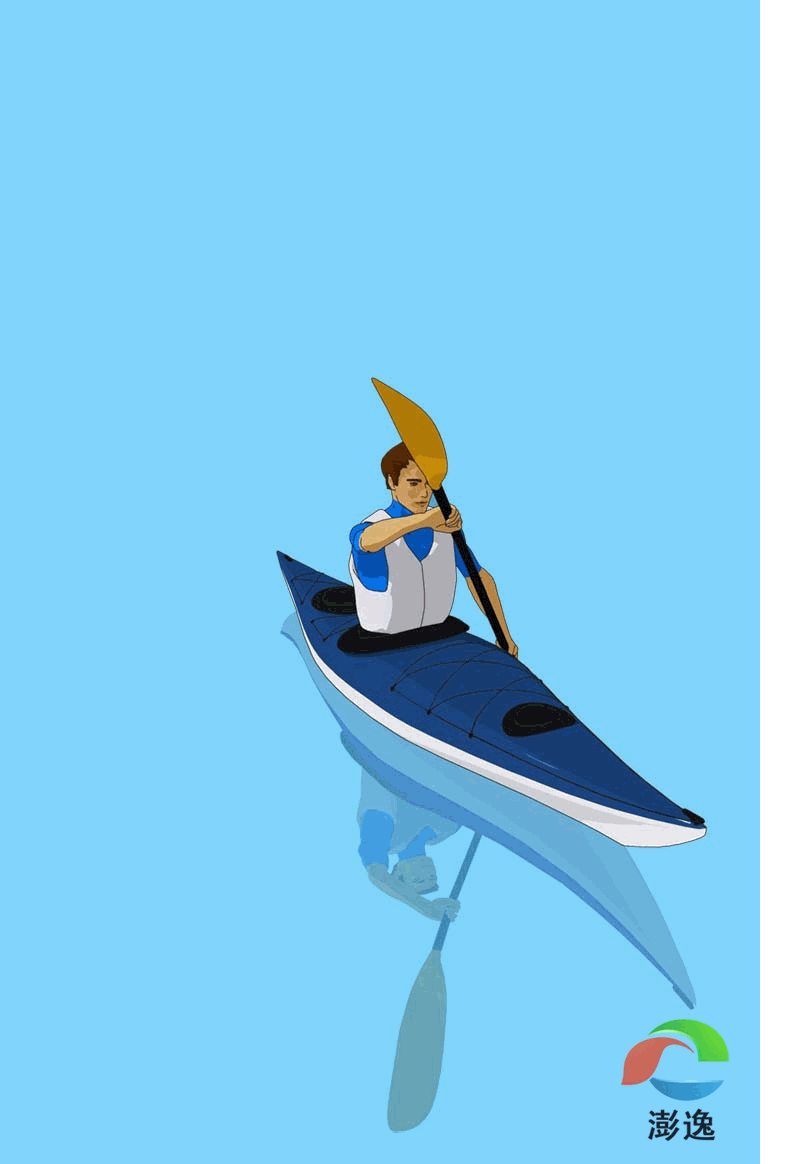
|
 2017-10-06 14:59:59 2017-10-06 14:59:59
|
Post #12
Re: 皮划艇基础教程-澎逸动画演示版 (第一节 码 ... |
 shusheng_100 shusheng_100
|
皮划艇基础教程-澎逸动画演示版 (第九课 横向平移) 皮划艇运动是国内才兴起的一项运动。是一项新兴起的运动,也是一项古老的运动。在国外蓬勃发展。国内也是渐渐兴起。对于皮划艇的基础知识的普及信息非常少。基于此澎逸收集整理制作了一系列教程。希望可以通过这个让大家更好的掌握皮划艇的技术技巧,享受皮划艇运动的健康快乐。 ----澎逸吴树升(欢迎 转载 注明出处) 横向平移皮划艇,有三种不同的桨法 1.抽拉法平移 2.提拉法平移 3.摇橹平移 抽拉平移比较简单,就是船桨不离开水面,船桨叶面垂直于船体的时候向远处划,然后拉向船体。 提拉平移,算是最基础的,把船桨离开水面,一下一下的拉向船体,实现平移 摇橹平移是最难的一个平移桨法,不过也是最优雅的桨法。优雅而且高效。本课主要讲解摇橹平移。 --编者备注 摇橹平移 Moving sideways with sculling draw 如果您想靠岸或是靠向友船,较好的动作是在船侧做类似摇橹的动作。 这个动作可能稍难掌握,但它的确能在方便保持平衡的状态下,提供最有效的横向移动。 When you want to move alongside a dock or a friend's kayak, one of the best techniques to use is the sculling draw. It might be slightly hard to master, but it is the most powerful way to make your kayak move sideways and keeping balance is easy.  使用正常的前向用桨握桨方式,身体倾侧,把桨几乎竖直地插入水中;您在上的手臂形成一个大约的直角,并保持这个高度;桨的受力面需要指向船体的一侧。 Hold your paddle with a normal forward paddling grip. Turn your torso to the side and put the paddle almost vertically into water. Your upper arm should be bent about 90 degrees and kept high. Check that the power face of a paddle is facing towards the kayak. 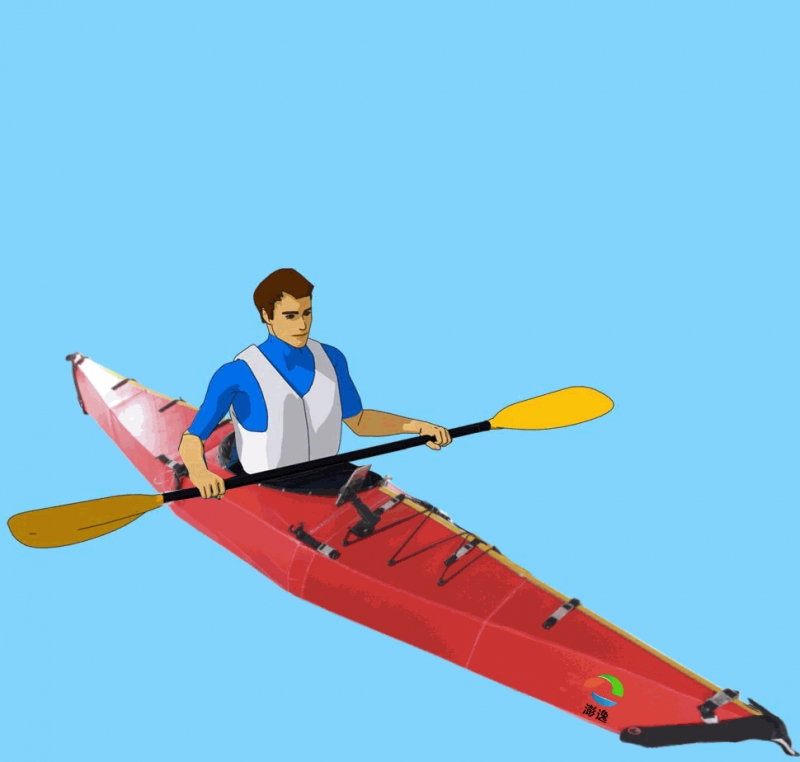 学习这个动作时,可以把桨在水中来回运动,尝试感受因为动桨不同,所产生的不同效果。如果桨相对船体平行运动,这会很省力;相反,如果让桨面在水中靠近或远离船体,就需要更大的力量。 但是,即使用上力气,简单地让桨面在水中靠近或远离船体,并不能高效地使船横向移动。 Now take a moment to feel how the paddle will behave in the water. You probably notice that the blade almost has its own will: it slices the water easily if you move the paddle parallel to your kayak. But to draw the blade closer to or further away from the kayak takes a lot more work. However, moving the paddle back and forth this way does very little to move the kayak. 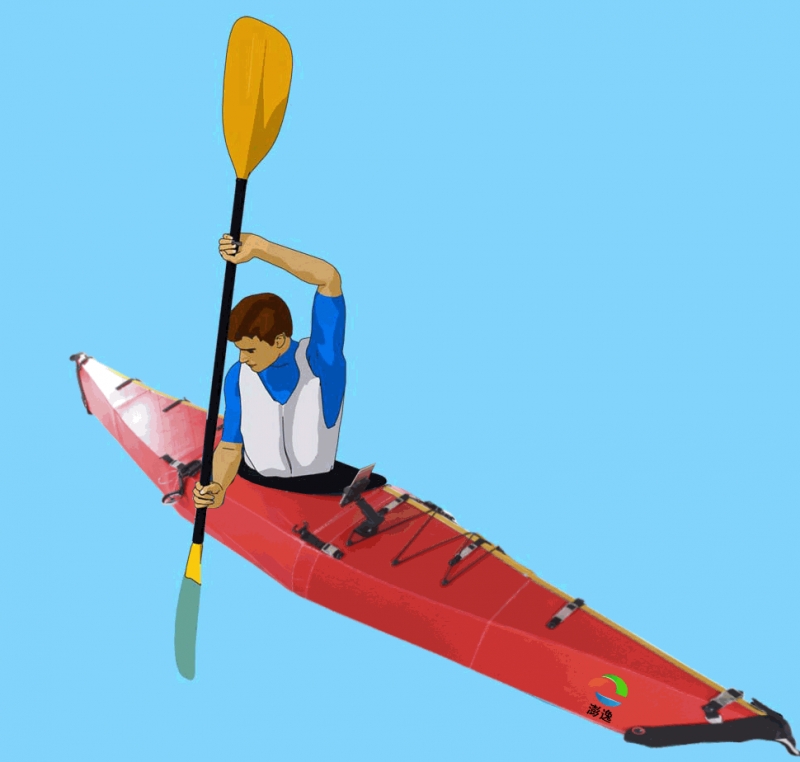 窍门在于,当用力让桨面在水中靠近或远离船体时,应该采用近似于船体平行的动作,而且保持桨的受力面相对来回用桨方向有一个小角度。这样做,可以高效地让船朝用桨一侧,横向移动。 这个动作在使用时,在上位的手位置几乎相对固定,使用在下位的手做动作。 尽量保持动作的连贯性,让桨面在水中划“窄8字”形状。您需要用力对抗防止,桨面因动作产生的切水趋势。 如果您想在一侧用桨,把船往另一侧横向移动,就把桨面的背面稍微对着桨运动的方向。但通常,采用第一种方式,在横向移动的同一侧用桨。 小提示: 掌握这个动作会比较难,最好的办法是,先用手而不是桨在水里感受,如此运动时,水的动态作用力,来体会学习。 The trick is to move the paddle back and forth parallel to the kayak while turning the blades' power face slightly toward the direction of the sweep. This draws the kayak towards the paddle. Keep your upper hand in a fairly fixed position, and start waving the blade in water by moving your lower hand. Try to keep the movement continuous; move the paddle so that it forms a thin figure 8 in the surface of water. You will have to resist the blade's tendency to slice the water. 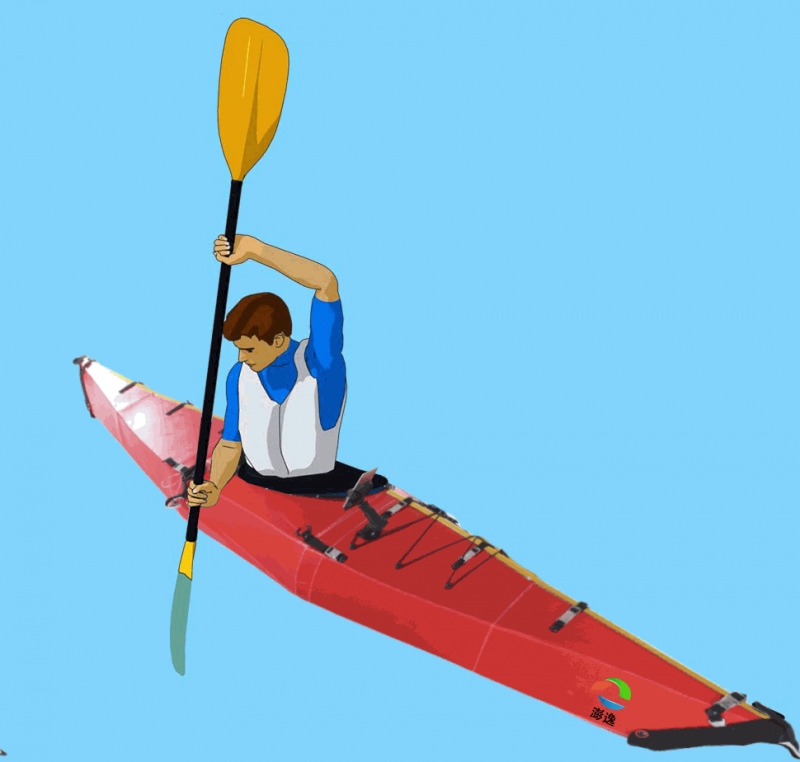
|
 2017-10-08 21:02:10 2017-10-08 21:02:10
|
Post #13
Re: 皮划艇基础教程-澎逸动画演示版 (第一节 码 ... |
 shusheng_100 shusheng_100
|
皮划艇基础教程-澎逸动画演示版 (第十课 倒划) 皮划艇运动是国内才兴起的一项运动。是一项新兴起的运动,也是一项古老的运动。在国外蓬勃发展。国内也是渐渐兴起。对于皮划艇的基础知识的普及信息非常少。基于此澎逸收集整理制作了一系列教程。希望可以通过这个让大家更好的掌握皮划艇的技术技巧,享受皮划艇运动的健康快乐。 ----澎逸吴树升(欢迎 转载 注明出处) 反向用桨 Paddling backwards 反向用桨,就是正向用桨的逆动作。一般我们在减速时使用。由于仅仅需要向后划几下以减速,所以动作的标准性并不重要,只要能保持平衡就可以了。 Paddling backwards technique is much the same as reversed forward paddling and can also be used for reducing speed in waves or when approaching for a rescue. Because you'll most likely need to paddle backwards just a few meters, the style doesn't matter so much as long you maintain your balance. 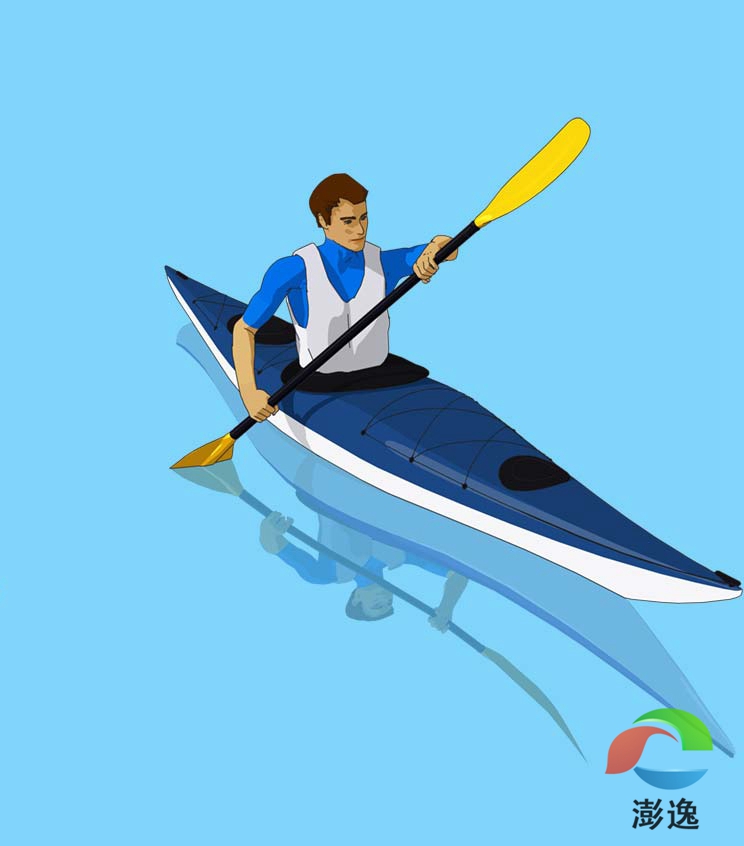 特别的是,如果您装有船尾舵,向后划可能会比较复杂。亦或船尾较宽大(重)时,可能会有些不可预计的转向。您可以通过向前弯下身形,来改变重量在船体的分布,减轻这个效果。 Paddling backwards can be tricky, especially if your kayak is equipped with a rudder. In such case press the both foot pedals to keep the rudder straight. Also, stern-heavy kayaks can behave unpredictably when paddled backwards, a problem you can overcome by leaning forward in the cockpit to lift weight from the stern. 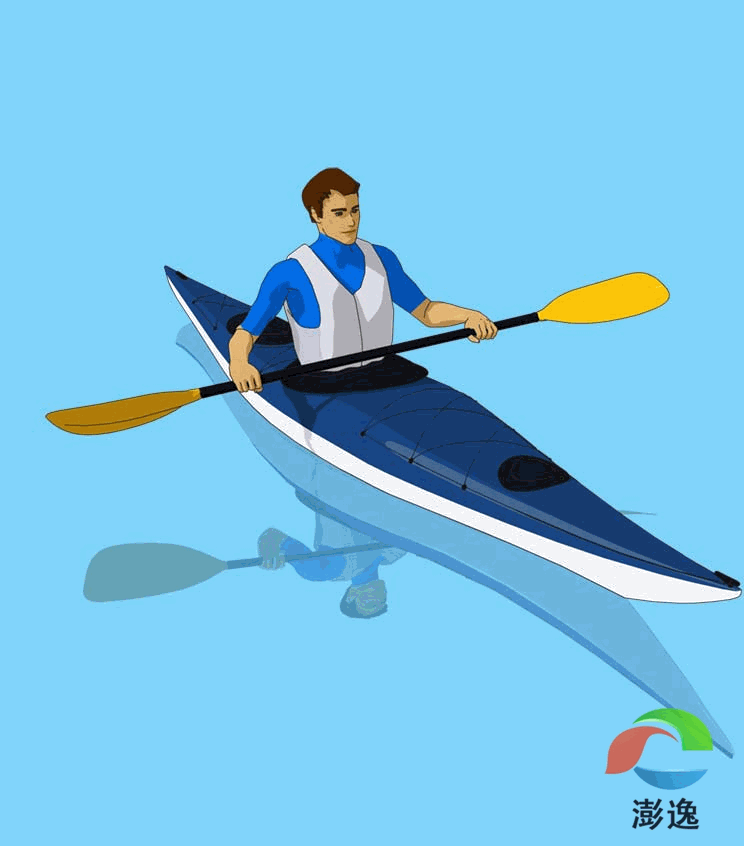
|
 2017-10-11 10:09:41 2017-10-11 10:09:41
|
Post #14
Re: 皮划艇基础教程-澎逸动画演示版 (第一节 码 ... |
 shusheng_100 shusheng_100
|
皮划艇基础教程-澎逸动画演示版 (第十一课 安全技术序言) 皮划艇运动是国内才兴起的一项运动。是一项新兴起的运动,也是一项古老的运动。在国外蓬勃发展。国内也是渐渐兴起。对于皮划艇的基础知识的普及信息非常少。基于此澎逸收集整理制作了一系列教程。希望可以通过这个让大家更好的掌握皮划艇的技术技巧,享受皮划艇运动的健康快乐。 ----澎逸吴树升(欢迎 转载 注明出处) 安全技术篇 Safe kayaking 皮划艇是个相对安全的运动,但是每个划船的人都应该对各种意外做好预案。这一章介绍的基本安全技术,将让您化险为夷。这些技术很容易学会,而且我们强烈建议您在正式划船前掌握好它们。 Kayaking is a relatively safe sport, but all paddlers should be prepared for accidents. Safety basics section covers the techniques that are required to successfully recover once you have capsized. They are fast to learn and it is recommended you master at least them before heading out with your kayak. 在掌握了基本安全技术之后,您可以开始学习压水平衡和爱斯基摩翻滚。这两样是较高阶的技术,使用它们经常能够及时地阻止危险出现。 After that you can learn to do braces and eskimo rolls. They are always a better option and can often prevent capsizing in the first place. 需要留心的是:在训练时能把某些技术做好,不等于在大风大浪,或者在您已经筋疲力尽时,也能做得同样好。所以需要经常不断地练习这些技术。 Remember that knowing how to do something in practise situation is not the same thing as actually doing it when the waves are big and you are tired. So keep practising every once in a while. 下面是一个有关安全方面的列表: See also the safety checklist below: 1 回避危险 -避免独自划船 -记得天气是经常瞬变的 -避免划得远离海岸 -携带一张标明岩石和海标的地图 -避免在航线附近划船 -如果天黑,使用头灯 -携带淡水和能量食品 1. Avoid risks - avoid paddling alone - remember that the weather can change rapidly - avoid paddling far from the coastline - have a map that shows rocks and seamarks - avoid paddling on ship routes - wear a head lamp etc. if it is dark - have fresh water and spare energy with you 2处理危险 -掌握很好的划船技术 -知道如何预防危险 2. Deal with the risks - have good enough paddling technique - know how to prevent capsizing 3 对意外状况有准备 -必须穿着救生衣 -知道覆舟后如何脱身并回到船上 -有用来给座舱排水的装备和知识 -在真实环境下能熟练运用安全技术 -在防水袋内放有手机 -在能隔水的地方有备用衣物 3. Be prepared for accidents - always wear life vest - know how to do a wet exit and get back in - have equipment and knowledge to empty your kayak - practise safety skills well and in real conditions - have a mobile phone in a waterproof container - have spare clothes in a dry place 4有预案 无论您如何在安全方面做准备,都不会说是多余的。 4. Have backup plans for everything. You can never be too prepared. 
|
 2017-10-13 10:22:11 2017-10-13 10:22:11
|
Post #15
Re: 皮划艇基础教程-澎逸动画演示版 (第一节 码 ... |
 shusheng_100 shusheng_100
|
皮划艇基础教程-澎逸动画演示版 (第十二课 湿逃脱) 皮划艇运动是国内才兴起的一项运动。是一项新兴起的运动,也是一项古老的运动。在国外蓬勃发展。国内也是渐渐兴起。对于皮划艇的基础知识的普及信息非常少。基于此澎逸收集整理制作了一系列教程。希望可以通过这个让大家更好的掌握皮划艇的技术技巧,享受皮划艇运动的健康快乐。 ----澎逸吴树升(欢迎 转载 注明出处) 湿逃脱是穿防水裙使用皮划艇的必备技能。在没有熟练掌握湿逃脱技巧前,使用皮划艇是不能使用防水裙的。可能会造成一定的危险。湿逃脱有几个关键点,第一是保护好船桨不能脱落遗失。第二在下水前一定要注意防水裙的救命绳是在外面的。第三关于动作用四步来记忆,1抱(抱住皮划艇,人头部贴住艇身,放置皮划艇飘动的时候头部撞上水底的石头)2拍(拍打皮划艇背部,提醒伙伴注意)3摸(摸有没有伙伴的艇靠近,前来救援)4脱(没有伙伴救援,用手拉住救命绳)脱离皮划艇。每个步骤都很重要。切实的做到位。----编者 湿逃脱(穿着防水群的脱离倾覆的皮划艇的方法) Exiting a capsized kayak 幸运地是,从翻覆的海洋舟中脱身常常是自动的。但是如何在不丢失船桨和海洋舟的情况下平稳出仓,这需要一些实践才行。 Luckily, getting out of a capsized kayak is usually almost automatic. But learning to do it calmly and without loosing hold from your paddle or kayak needs a little practice.  您应该懂得在如何水下行动或拖着船游泳,这在练习爱斯基摩翻滚时,压水平衡时或其他容易导致湿身的情况下,特别有用。 从翻覆的海洋舟中脱身只需要几秒钟,所以您不必是个潜水强人。但在练习时,最好还是有和同伴相陪,而且需要先查明一下练习地点有足够的水深,否则您可能会头部撞到水底而受伤。 You should know how to act underwater or swim with the kayak especially if you want to practise eskimo rolls, braces or other things where getting wet is inevitable.Remember that getting out of the capsized kayak takes only a few seconds so you don't have to be a diving master. But always have a friend nearby when practising. Also check that the water is deep enough so that you won't be banging your head to the bottom.  练习开始时,可能不穿防水裙为好,但我们需要明白在穿着防水裙时如何动作。 检查防水裙的带子(救命绳)在您伸手可及的地方。把您的膝盖抵住海洋舟的甲板,这样您在海洋舟翻覆后仍能在船舱里坐稳。用正常握桨手法握桨。 在翻覆时,吸气并向翻覆的一边稍微侧身。舟翻过来后,首先保持冷静,体位放正。 First it might be a good idea to practice without a spray skirt, but now we are going to see how things are done with the skirt. Check that the spray skirt's handle is at your reach. Push your knees tightly against the deck so that you are able to sit tightly even after the kayak capsizes. Hold the paddle with a normal paddling grip. Breathe in and lean forward and to the side until you capsize. 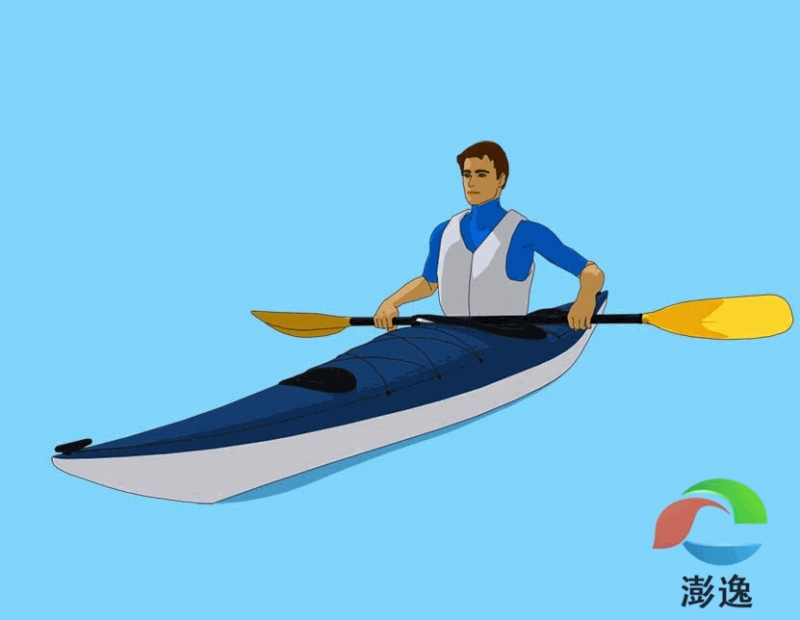 如果您有朋友在附近,您可以试着让他们看到并得到帮助。这时,把船桨固定在您的腹部和舟之间,以防船桨漂走。双周拍击朝上的船底,以引起朋友们的注意。如果您的朋友行动及时,他们能用自己kayak的船首靠近您,让您用手按着其船首翻过您的kayak来。 这个技术属于有协助的爱斯基摩翻转,也是最简单的一种方法。但更经常的情况时,您在翻船后,没有足够的时间或耐心等待您朋友的到来,这时您可以选择自己出舱。 First try to stay calm and orientate. If you have friends nearby you can try to get help from them. Put your paddle between your hands and your stomach so that it does not float away. Bang the bottom of the kayak to get the attention of other paddlers and start waving your hands above the surface. If your friend is fast enough, he can bring his kayak's bow to your reach and you can pull yourself up by holding it. This method is called an assisted eskimo rescue. But most likely you don't have the time nor patience to wait until your friend's arrival so you need to get out. 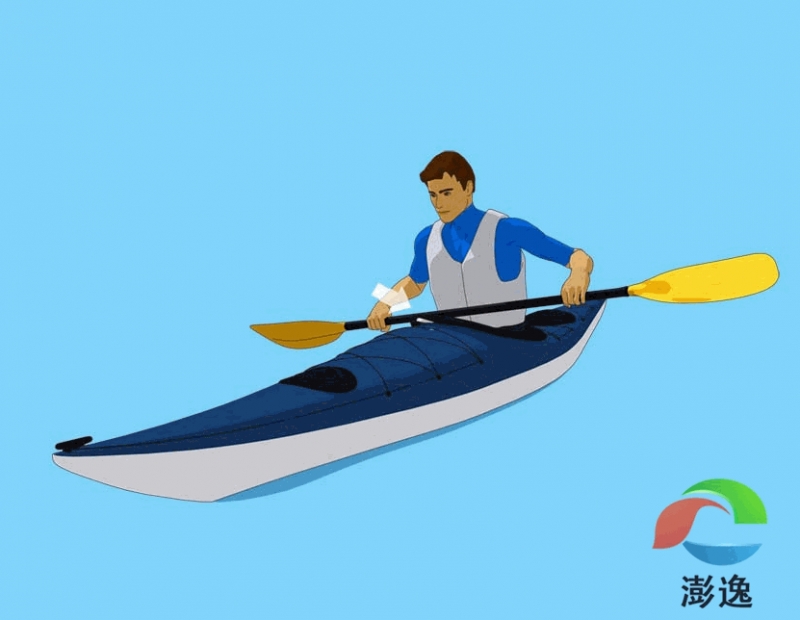 当您准备好出舱后,把握好船桨以防丢失,然后打开防水裙。(防水裙的拉手应该好好放置在裙的外侧)。翻身出舱时,船桨放在双臂之间,一手牢牢抓住舱沿,然后钻出舱来到kayak的一侧。过程中尽量让头先出水面,以免受到撞击。最后可以把双脚在水下抵住舱边沿,可以有效的防止失去kayak。 When you feel like ready to exit the kayak, place the paddle securely to your lap, grab the spray skirt's handle and pull the skirt off. TIP: – If for some reason the handle would have been accidentally left inside the spray skirt, you could remove the skirt just by grabbing straight from the edge of it and pulling. Usually the best place for this is at the side. 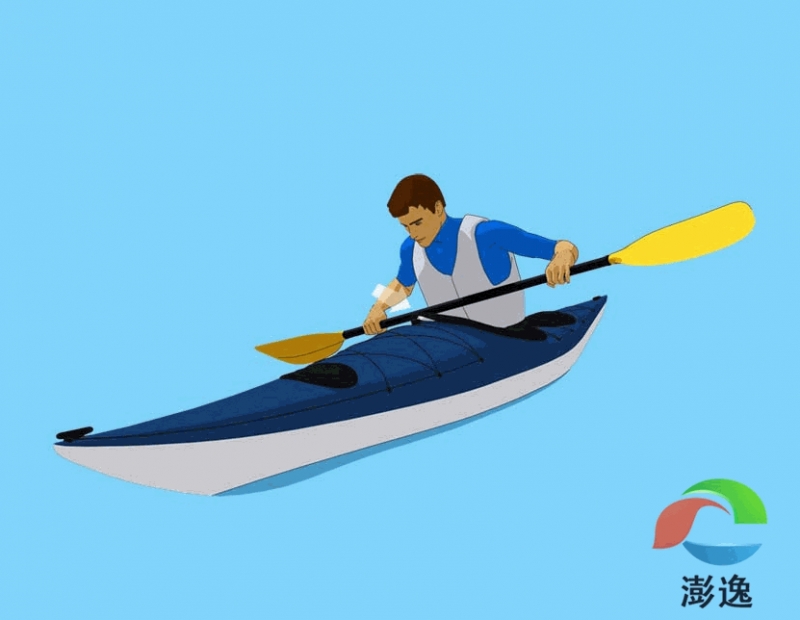 一抱 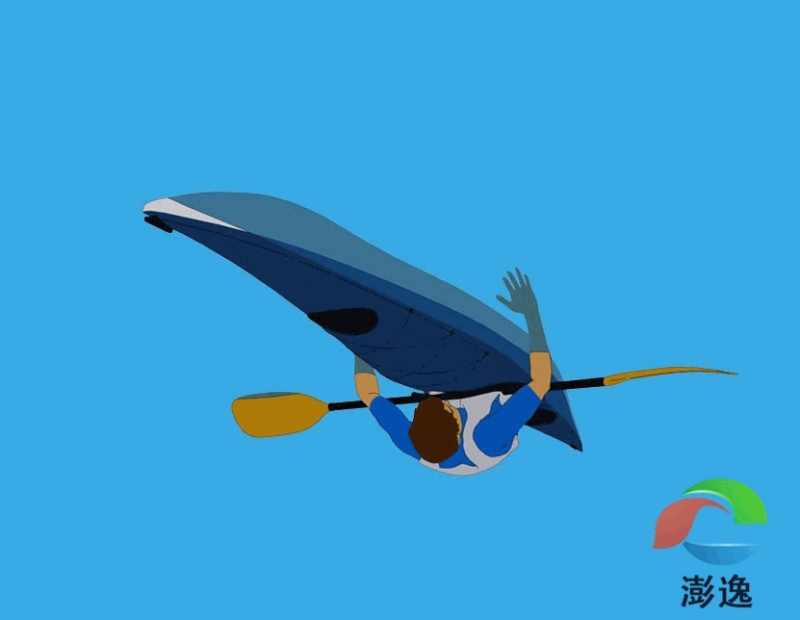 二拍  三摸  四脱 出舱后,如果您不得不拖着kayak游泳,那么最好是让kayak底部朝上。这样一来舱内的空气使kayak难以沉没,而且浪也不会再往舱中灌水。不管什么原因,您丢失了船和桨,那么先去抓船,然后再去找桨。应该风浪更容易带走kayak,而桨可能还在原处。 带着kayak游泳的最好办法是拖着它游。首先,把握住船首,把桨也用同一只手控制住。泳姿这是并不重要。 带着kayak游泳是件在好天气下也很困难的事情,而且附近可能远离陆地。所以我们需要其他的办法也自救。一个绝对需要记住的事:觉得不要放弃您的kayak,即使它已经半沉了。因为它还能让你浮在水上,而且救援时,发现kayak比发现游泳者要容易。 If you are forced to swim with the kayak it is usually a good idea to keep it upside down. This way the air that is trapped inside the kayak will prevent the kayak from sinking and the waves will not splash extra water inside the cockpit. If for some reason you have lost the hold of your kayak or your paddle, reach to your kayak first and then look for your paddle. The reason for this is that the wind and waves will push the kayak further quite easily, but most likely your paddle will stay at its place. The best way to swim with the kayak is by pulling it. First grab the kayak from its bow and put the paddle to that same hand. The swimming technique doesn't really matter. Swimming with the kayak is extremely hard even at the good weather and there might not be any land nearby. Therefore it is essential to also learn other methods to rescue yourself. One good rule of thumb is that you should never abandon your kayak since - even if it would be half sunken - it will keep you above the surface and spotting a kayak out of the water is much easier compared to a lonesome swimmer. |
 2017-10-16 07:26:52 2017-10-16 07:26:52
|
Post #16
Re: 皮划艇基础教程-澎逸动画演示版 (第一节 码 ... |
 shusheng_100 shusheng_100
|
皮划艇基础教程-澎逸动画演示版 (第十三课 他人协助反转船体排水) 皮划艇运动是国内才兴起的一项运动。是一项新兴起的运动,也是一项古老的运动。在国外蓬勃发展。国内也是渐渐兴起。对于皮划艇的基础知识的普及信息非常少。基于此澎逸收集整理制作了一系列教程。希望可以通过这个让大家更好的掌握皮划艇的技术技巧,享受皮划艇运动的健康快乐。 ----澎逸吴树升(欢迎 转载 注明出处) 他人协助反转船体排水 Assisted kayak emptying 如果您翻船后,想重新坐回kayak,那么首先最好先将kayak中的水尽量排除。因为坐在装满水的kayak中划行并保持平衡不是件容易的事,或靠用排水泵或水勺排水也挺费时。现在让我们学习如果在有其他kayak同伴协助下排水。需要注意的是,这里讲的技术使用与有密封舱或船首尾有浮力舱的kayak。还需要注意的是,不能在排水过程中把同伴的kayak也搞翻了,否则两个人都翻船事情就更复杂了。另外,参加救助的kayak最好帮着管好两人的船桨,知道救助结束。 If you have fallen and decide to climb back into your kayak, it is usually better to first try getting most of the water out of the cockpit. This is so because keeping balance with a kayak that has free flowing water inside is difficult and emptying the kayak only with a pump or bailer takes time. Now we will learn to empty the kayak with help of a fellow paddler. Notice that this technique is suitable only for kayaks that have waterproof sections or floats on both ends. First of all, be extra careful not to capsize your friend also, since things will be far more difficult if both of you are in the water. It is also better that the assisting kayaker takes care of storing both of the paddles untill the rescued is safely in his kayak. 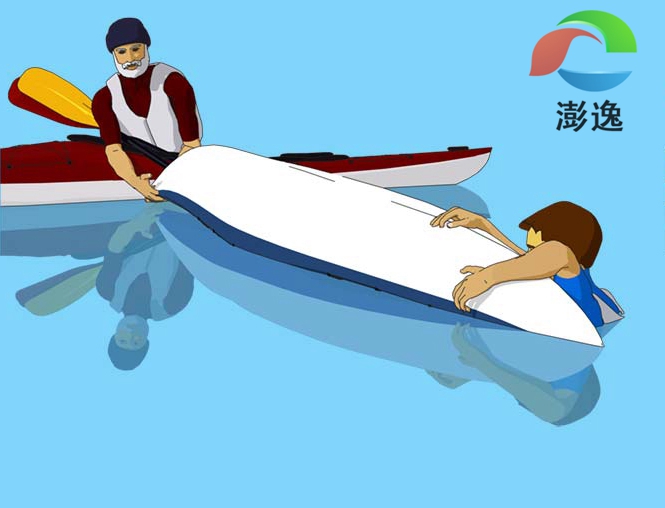 保持翻覆的kayak船底朝上,把该船的船首推给您的同伴,放上他kayak的甲板。您可以在水中帮忙压低您的船尾。如果您的kayak太重,可以在水中先翻回正面向上,利用船首弧度滑推到同伴kayak船桥上。 Keep the capsized kayak upside down. Give your kayak's bow to your friend and help him to lift it on his deck. You can help your friend either by lifting the bow up or by pushing the stern down. If the kayak is still too heavy, you can flip the kayak on its side so that it is easier to pull it on the deck. 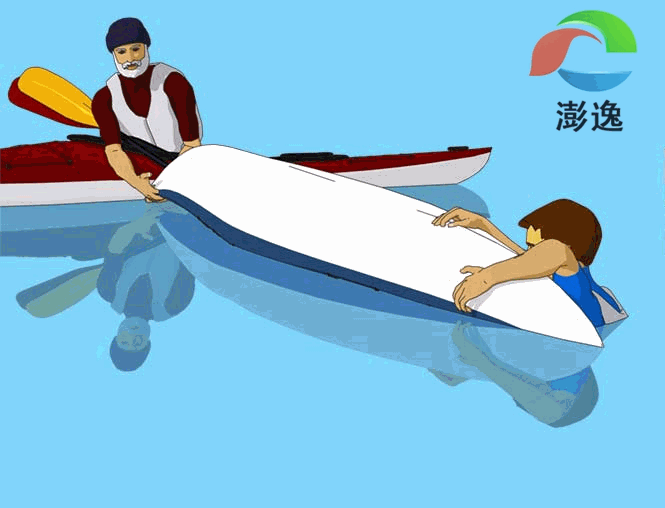 一旦您的船首被顺利放在同伴的kayak上,您就可以让船保持船底向上的位置以使水从坐舱内流出。您的同伴这时也可以帮助着把您的船太高,加快排水速度。 Once the kayak's bow has been successfully pulled to the deck, you should keep the kayak upside down so that the water flows away from the cockpit. Your friend can also lift the kayak up in the air to boost the operation. 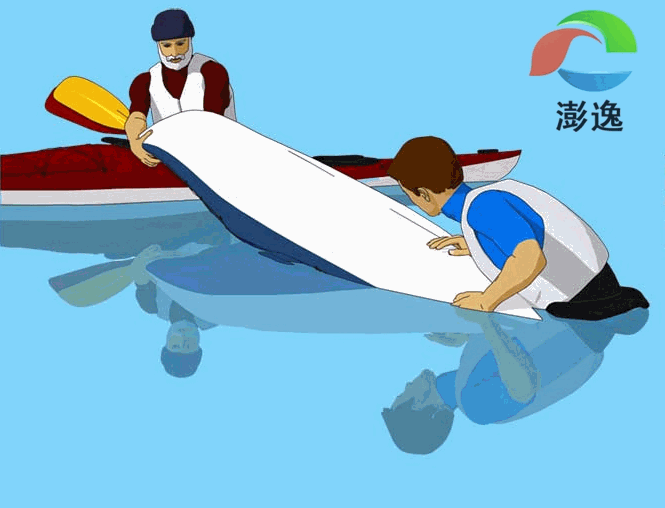 等水排得差不多了,您的同伴就可以把您的kayak翻过来到正面向上的位置。然后您可以使用例如“足跟后挂式”(请见“他人协助重新入船”一章)等技术,重新坐回到kayak中。 Once the kayak is empty, your friend can flip it back upright and you can climb back in for example using a heel hook technique that is described in tutorial Assisted re-entry  如果您的kayak实在太重,不能用此方案排水,那么只能先坐回kayak中,用排水泵或水勺来排水。 TIP: –If the kayak is so heavy that emptying it by lifting is not possible, you should first climb back in and do the emptying with pump or bailer while your friend holds the kayaks together. 完整动画 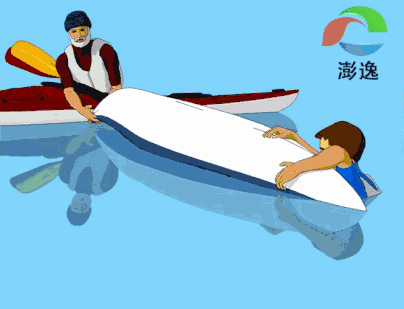
|
|
shusheng_100 于 2017-10-19 17:08:21 编辑
|
|
 2017-10-16 20:46:03 2017-10-16 20:46:03
|
Post #17
Re: 皮划艇基础教程-澎逸动画演示版 (第一节 码 ... |
 小亮大山 小亮大山
|
新手来学习 |
|
---------------------------------------- |
|
 2017-10-17 18:59:07 2017-10-17 18:59:07
|
Post #18
Re: 皮划艇基础教程-澎逸动画演示版 (第一节 码 ... |
 shusheng_100 shusheng_100
|
小亮大山 wrote: 新手来学习 欢迎加入皮划艇队伍! |
 2017-10-19 17:07:22 2017-10-19 17:07:22
|
Post #19
Re: 皮划艇基础教程-澎逸动画演示版 (第一节 码 ... |
 shusheng_100 shusheng_100
|
皮划艇基础教程-澎逸动画演示版 (第十四课 浆包自助排水反转船体) 皮划艇运动是国内才兴起的一项运动。是一项新兴起的运动,也是一项古老的运动。在国外蓬勃发展。国内也是渐渐兴起。对于皮划艇的基础知识的普及信息非常少。基于此澎逸收集整理制作了一系列教程。希望可以通过这个让大家更好的掌握皮划艇的技术技巧,享受皮划艇运动的健康快乐。 ----澎逸吴树升(欢迎 转载 注明出处) 浆包自助排水反转船体 Emptying kayak by self 在无艇友帮助的情况下处理翻覆的kayak,也是可以的,但需要你身体够强壮,而且有一种叫做 船桨浮力袋的小装备。请谨记,对于孤身一人划船的情况,船桨浮力袋是个必须的装备。 在翻船后,最好先把船舱内的水排干净,再坐回舱内,重新划船,否则残留舱内的水,会让你划船时难以保持船体的平衡。在排完大部分的水后,可以坐回舱内,用海绵,排水气筒等小工具慢慢排水。 Usually a capsized kayak can be emptied fairly well without assistance. However, compared to emptying kayak with an assisting kayaker, you might like to have a bit more strength and a proper paddle float. Remember that for a lone paddler, a paddle float is a must thing to have. It is a good idea to try have the kayak emptied before climbing back in, since even a fairly little amount of free flowing water inside the cockpit can make it almost impossible to keep the kayak in balance. After you have successfully emptied the kayak from most water and climbed in, you can get rid of the remaining water by using a bailer/cup or a pump. Notice that the technique we are about to learn is suitable only for kayaks that have waterproof sections or floats on both ends.  排水时,kaykak船底朝上,船首抬离水面,这样舱内的水会被倒出来。具体步骤: 人在水中,把船桨浮力袋充好气,套在船桨上,把kayak底朝上,船首搁在一侧肩上,如图所示把船桨架在另一侧肩上。 The kayak should be emptied by keeping it upside down and lifting the bow up so that the water that is trapped inside can flow away. First attach the paddle float into the paddle and inflate it well. Place the bow of your kayak against the shoulder on your stronger hands side and place the paddle against your other shoulder as shown in the picture. 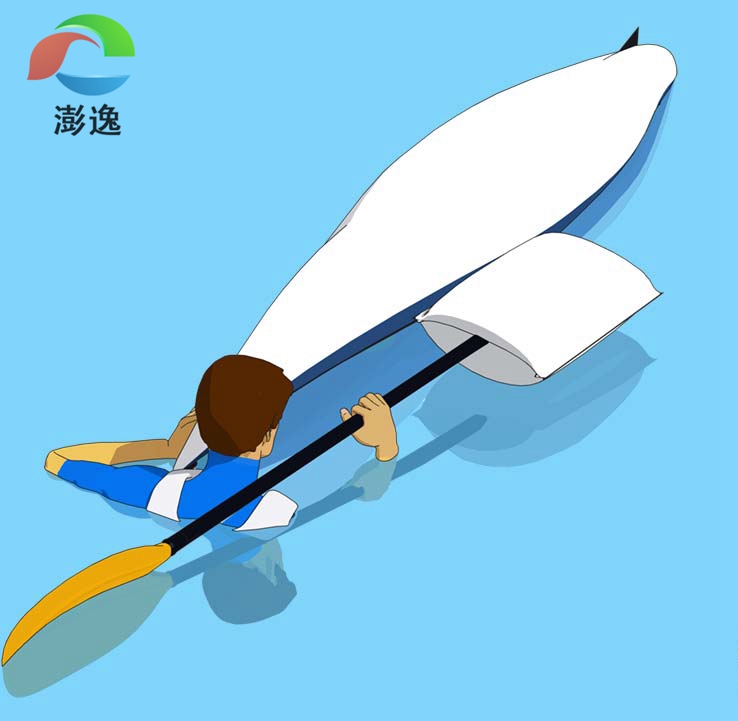 迅速且有力地用手把肩膀上的船首抬起,另一只手同时用力下压船桨,以借助船桨浮力袋的浮力,同时两腿可以向下踩水,增加向上的力量,也免得自己完全浸没水下,这时排水开始 Take a firm grip from the bow and the paddle and quickly lift the kayak up in the air. Pull the paddle down simultaneously to prevent you from getting under the surface. You can also try to kick yourself up with your feet. 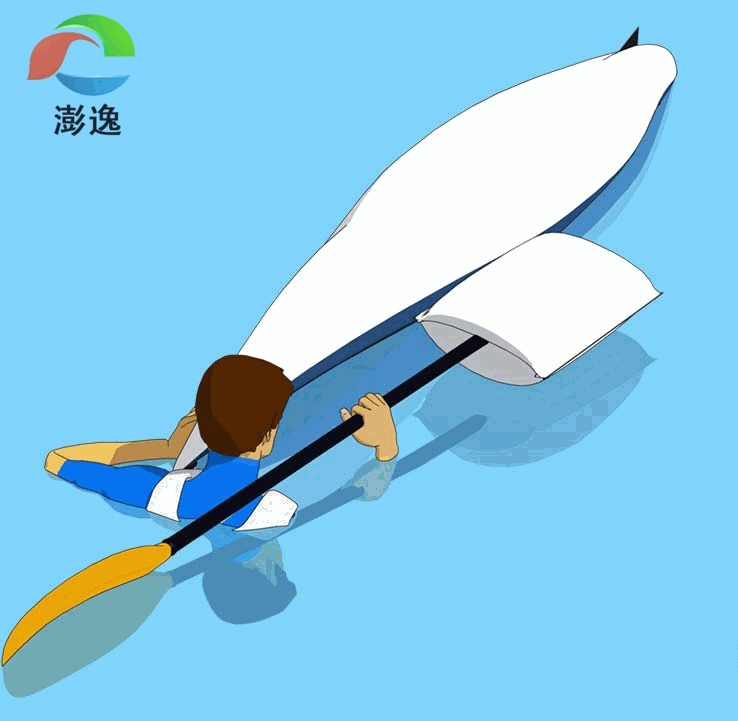 当快要力尽,船身要下落入水前,翻转举起船体的手腕,让kayak正面朝上 When you feel that the kayak starts to come down, you can flip it upright. If there is a lot of water inside the kayak, you can repeat the operation a couple of times before flipping the kayak back upright.  完整的动画展示过程 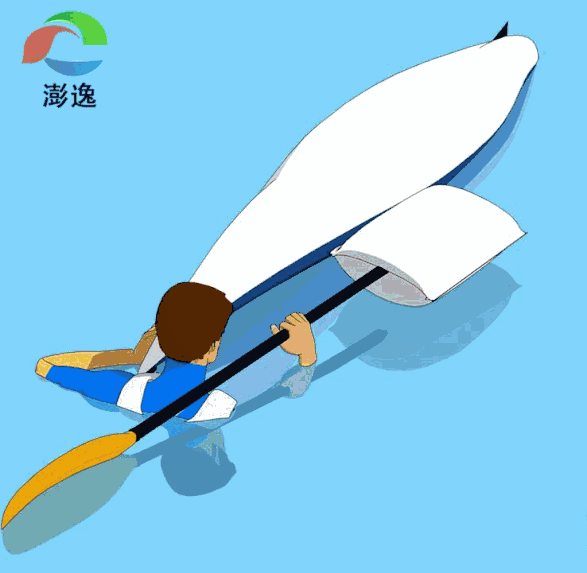
|
 2017-10-22 21:41:05 2017-10-22 21:41:05
|
Post #20
Re: 皮划艇基础教程-澎逸动画演示版 (第一节 码 ... |
 shusheng_100 shusheng_100
|
皮划艇基础教程-澎逸动画演示版 (第十五节 H型救援-他人协助上艇) 皮划艇运动是国内才兴起的一项运动。是一项新兴起的运动,也是一项古老的运动。在国外蓬勃发展。国内也是渐渐兴起。对于皮划艇的基础知识的普及信息非常少。基于此澎逸收集整理制作了一系列教程。希望可以通过这个让大家更好的掌握皮划艇的技术技巧,享受皮划艇运动的健康快乐。 ----澎逸吴树升(欢迎 转载 注明出处) 足挂式救援 (H型上艇) Heel hook rescue 有多种办法让一个不小心掉到水中的舟友重新坐回舱内。哪一种方法最好?要视具体的情况而定。现在我们介绍一种脚跟挂足式方法。相对著名的“X”式方法,本方法更加灵活,需要的上身力量也相对较少。 请注意,重新入船前需要尽可能多地排掉舱内的水。具体方法参考上一节。具体入船步骤如下: There are numerous different methods to assist an unfortunate paddler back to kayak. The best technique depends on the situation. The technique that we are now about to learn is called "heel hook rescue". It is one of the most reliable techniques. And for example, if compared to more famous x-rescue, the heel hook requires a lot less upper body strength and flexibility. Note that it might be a good idea to empty the kayak from most of the water before the paddler gets back in. The method for emptying the kayak is explained in tutorial Assisted kayak emptying. On the next pages we will see the heel hook rescue done step by step. 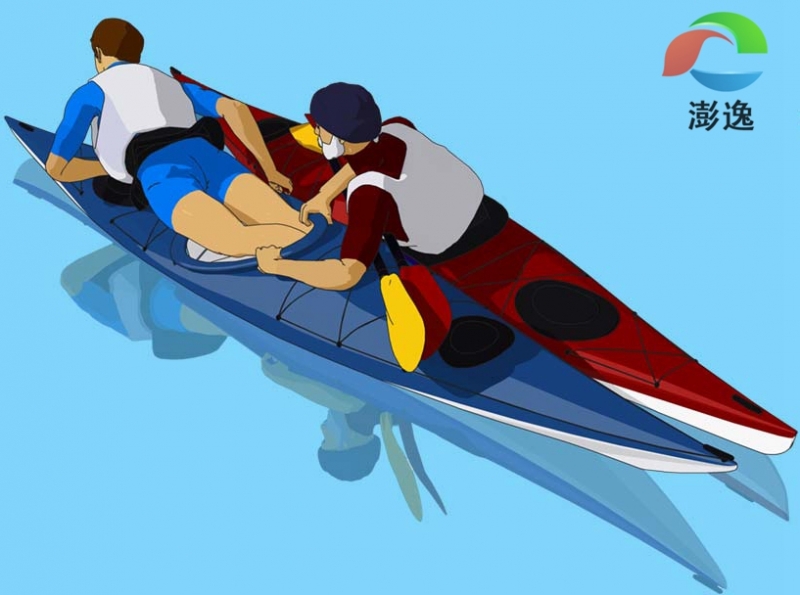 协助救援的舟友把自己的kayak靠近已经排掉舱内入水的翻覆kayak。最好以两船首方向相反的方式让两船相互紧挨着。这时,两船有一端会成一个小角度。救援舟友负责保管两人的船桨,放在两船之上,这样船桨不会丢失,而且救援者能腾出双手,来抓牢对方kayak的座舱前缘。救援者这时身体倾向被救援kayak一侧,身体大致位于被救援kayak座舱前缘上方。 The helper places the kayak right next to the swimmer's kayak so that the kayaks bows point to opposite directions. Then the helper takes the swimmers paddle and puts both of the paddles on his lap. There they are safe and leave both hands free so that the helper can take a firm grip over the swimmer's kayak's cockpit coaming. The swimmer positions himself to the other side of his own kayak, right behind the cockpit. 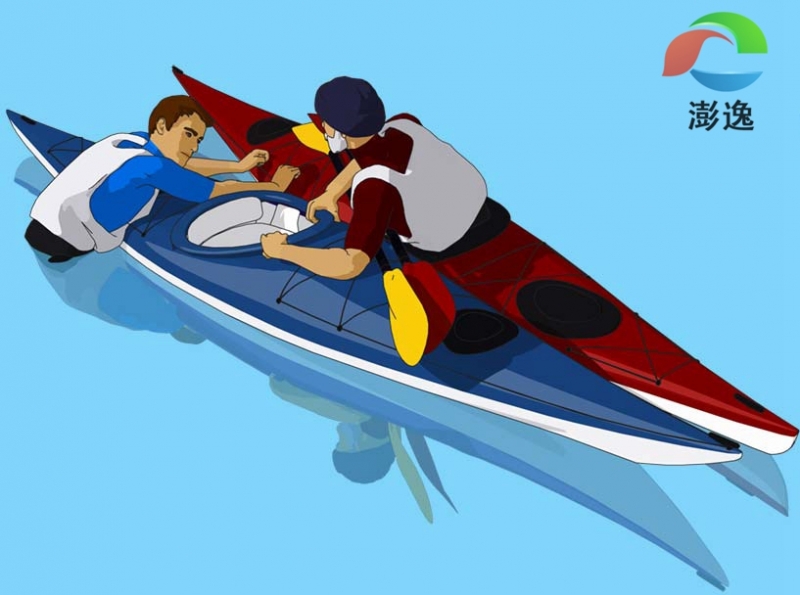 落水的舟友双臂越过自己船座舱后甲板,紧抓住救援舟友的kayak。抓的部分可以是kayak上的护绳,也可以是对方的座舱边缘。然后落水周友爬上座舱后部,同时顺势把一只脚伸入自己的座舱中,把脚面卡在座舱底和座舱前缘之间。 The swimmer places his arms on the rear deck of his own kayak and takes a grip from the helper's kayak, either from the deck ropes or from the cockpit coaming. Then the swimmer pulls his upper body on the rear deck and simultaneously swings the other leg inside the cockpit and hooks the heel inside the cockpit, right under the front deck.  当卡好这只脚之后,就很容易利用该腿的力量,把自己转身翻上kayak。请注意,这一过程需要救援周友用较大的力气抓牢落水周友的kayak,而且落水者应该避免使用突然性的快速动作。 After the heel is hooked inside, it is fairly easy for the swimmer to pull himself on the rear deck by using his leg muscles. Remember that this phase may require a lot of strength from the helper, so swimmer should avoid doing any fast movements. 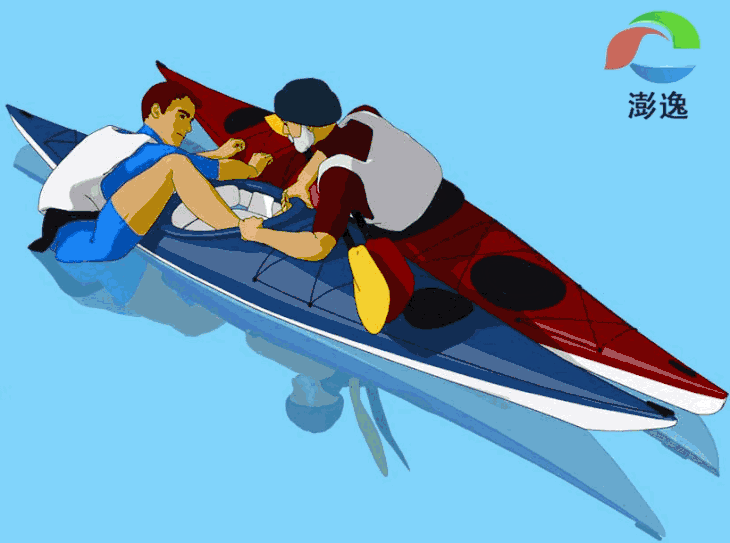 落水周友翻上自己kayak后,将双脚伸入座舱,调整好坐姿。救援周友仍需要确保两kayak靠在一起,等对方用排水气筒排完舱内余水,并把防水裙重新装好后,才算结束。 The swimmer moves his both legs to cockpit and carefully turns himself back to sitting position. The helper keeps the kayaks together until the swimmer gets his spray skirt secured and pumps the remaining water out with a water pump or bailer.  完整的运作动画 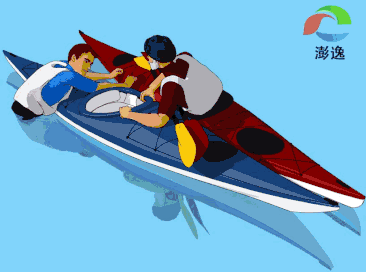
|
 2017-10-27 10:42:18 2017-10-27 10:42:18
|
Post #21
Re: 皮划艇基础教程-澎逸动画演示版 (第一节 码 ... |
 shusheng_100 shusheng_100
|
皮划艇基础教程-澎逸动画演示版 (第十六课 浮桨包上艇) 皮划艇运动是国内才兴起的一项运动。是一项新兴起的运动,也是一项古老的运动。在国外蓬勃发展。国内也是渐渐兴起。对于皮划艇的基础知识的普及信息非常少。基于此澎逸收集整理制作了一系列教程。希望可以通过这个让大家更好的掌握皮划艇的技术技巧,享受皮划艇运动的健康快乐。 ----澎逸吴树升(欢迎 转载 注明出处) 浮桨包上艇 Paddle float re-entry 对于单独一人出海的周友来说,准备一个船桨浮力袋而且会正确使用它帮助自己落水后上船,是件很重要的事。船桨浮力袋可以用泡沫块来代替,但最好是使用可充气的那种。在最危急时刻,也可以用自己的救生衣来做个简易的船桨浮力袋。但在那时,脱掉自己的救生衣,并不是个好主意。 At least for a lone paddler it is really important to have a paddle float and to actually know how to use it to climb back into the kayak. A paddle float can be made of closed cell foam, but usually it is inflatable. And in emergency situation, you could probably make one from your life jacket, although undressing it is generally not a good idea. 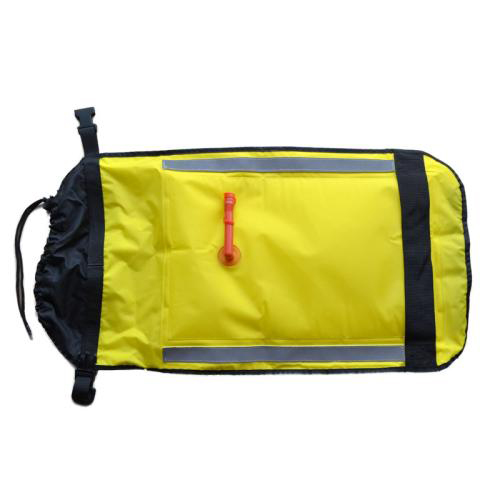 请注意,即使您平时懂得翻船后爬上去的技巧,但如果天气恶劣,那么这也不再是件容易的事。如果你从来不练习,那么您在静水上也会遇到困难。有很多利用船桨浮力袋上船的方法,我们介绍最简单通用的一种。 Note that if the weather is rough, climbing back into the kayak is a task even if you know the tricks. And if you have not practised at all, your changes of succeeding would be slim even in calm weather. There are some variations to the paddle float re-entry, but we will learn the one that works well on all kayaks. 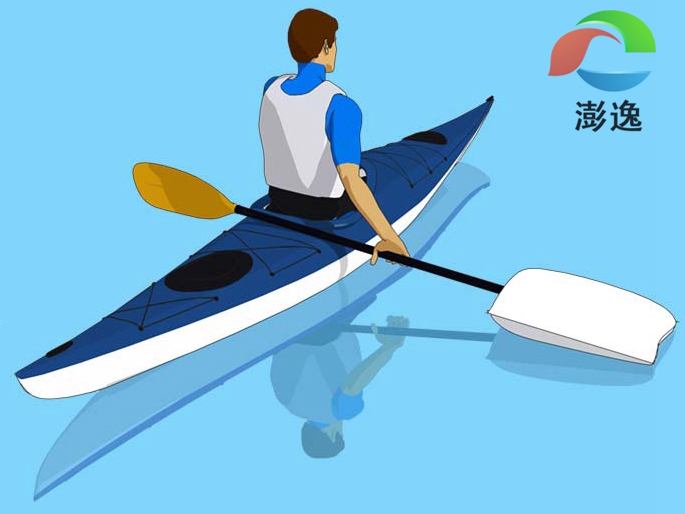 如果在风大的时候,在上风侧上船会比较困难。 给您的船桨浮力袋吹点气,套在船桨一面上,再吹足气。重新上船前,最好尽可能地排出座舱中的水。把没有套浮力袋的船桨一面,用手压在kayak后舱沿。有人说可以把没有套浮力袋的船桨一边插入kayak的甲板绳下面,但那样往往使事情变得复杂。然后尝试上船,如果失败,再使用“船桨一边插入kayak的甲板绳下面”的方式上船。 If the weather is windy get to the upwind side of the kayak so that your legs will not go under the kayak when the wind pushes it. Take your paddle float, put a little bit of air into it and secure it onto your paddle blade. Then fill the float until it is full. TIP: – you also need to flip your kayak back upright and try to remove most of the water from the cockpit. See more at tutorial Emptying Kayak by Self. 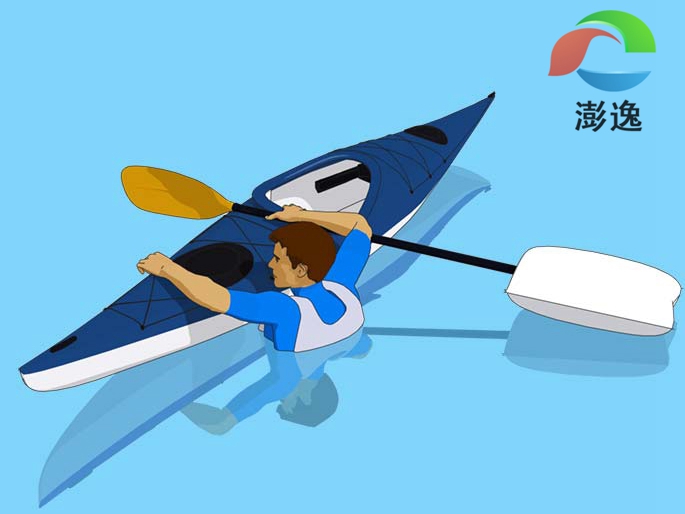 上船前,人位于kayak后侧旁边,在船和套好了船桨浮力袋的船桨之间。一手抓牢船舱后沿并同时压牢船桨。另一手攀牢kayak后侧的甲板绳。确保kayak中心线和船桨成90度的直角,这样船桨浮力袋能发挥最好的支撑作用。 Place the other paddle blade on to the rear deck of your kayak right behind the cockpit coaming. Some people say it is a good idea to secure the paddle under the deck ropes, but it could make things difficult later. Therefore you should first try to do the re-entry without securing the paddle, and only if it fails, use the ropes to make a fixed floating support.  双手一撑,从水中跳起,使上身趴在kayak后部,同时顺势把一只脚架上船桨,然后架上另一只脚。在这过程中,需要保持船桨和kayak成90度。 Jump up and pull your upper body to the rear deck. Quickly raise your other leg and hook it over the paddle. Then raise also the other leg over the paddle and try to keep the paddle and kayak in 90 degrees angle.  把上身在kayak后部摆正在kayak中心线偏船桨浮力袋侧(稍微借船桨浮力)。把一只脚伸入船舱。同时再检查船桨于kayak成90度。一手抓住船桨借力,另一只脚伸入船舱。如果当时有浪,就需要时刻准备着借力于船桨浮力袋来保持平衡。 Stay at the stern side, so that the paddle is between you and the cockpit. Grab the paddle and the cockpit coaming and place your arm over the paddle. Grab your other hand to deck ropes or what ever that gives you a good grip. Check that the paddle and kayak are in 90 degrees angle to each other and sort of forms a letter T, if looked from up. This way the paddle will give you the best possible support.  把自己调整到正常坐姿,记得随时借力于有船桨浮力袋的那一侧。 Slide your body more onto the rear deck while keeping your weight slightly on the paddle floats side. Move your other leg into the cockpit. Check again that the paddle and kayak are roughly in 90 degrees angle. Move the other hand to the paddle, hold tightly and swing also your other leg into the cockpit. If there are waves, be prepared to lean quite intensely to the paddle float.  当您已经成功的坐回舱内,可以把船桨拿出水里,但别急着拆掉船桨浮力袋。在给座舱排余水时,还有重新安装防水裙时,都可以使用船桨浮力袋来帮助平衡。 贴士: 在恶劣天气时,落水后爬回船舱会是个难事。即使您会爱斯基摩翻滚,也可由于种种原因没能成功实现翻滚,这时,使用船桨浮力袋方式上船,就是个好办法。 Flip your self back to sitting position and remember to keep the balance slightly on the paddle floats side. After you are successfully got back in, you can swing the paddle to your front side, but don't remove the paddle float yet. Try to empty the kayak from remaining water and secure the spray skirt while using the paddle float as a support. TIP: – In bad weather, climbing back to your kayak can be a difficult task. If you know how to do an eskimo roll, but have failed for some reason, a good idea might be to try doing a re-entry and roll with extra support from paddle float.  完整借助浮桨包的上艇过程 |
 2017-11-01 21:22:00 2017-11-01 21:22:00
|
Post #22
Re: 皮划艇基础教程-澎逸动画演示版 (第一节 码 ... |
 shusheng_100 shusheng_100
|
皮划艇基础教程-澎逸动画演示版 (第十七课 皮划艇支撑和爱斯基摩翻滚基础) 皮划艇运动是国内才兴起的一项运动。是一项新兴起的运动,也是一项古老的运动。在国外蓬勃发展。国内也是渐渐兴起。对于皮划艇的基础知识的普及信息非常少。基于此澎逸收集整理制作了一系列教程。希望可以通过这个让大家更好的掌握皮划艇的技术技巧,享受皮划艇运动的健康快乐。 ----澎逸吴树升(欢迎 转载 注明出处) 皮划艇支撑和爱斯基摩翻滚基础 Braces and rolling basics 想要进一步的完全控制你的皮划艇就需要学会得到水的支持恢复平衡。但是我们在学习爱斯基摩翻滚或者支撑之前,我们必须了解一些基本的原理和技术。这使我们能够将我们的技能应用到各种不同的现实环境中。由于使用这些技能的时机非常短暂。所以我们必须达到肌肉记忆,自然而然的做到这些动作。这样意味着我们应该经常练习,形成习惯的自然反应。这一章中,我们可以学习技巧训练。另外需要注意的是,在练习这些技巧的时候,会经常造成翻艇,人会被皮划艇扣在底下。因此我们应该避免单独练习这些技术。 One step towards the total control of your kayak is being able to recover your balance by getting support from water. But, before we learn to do eskimo rolls or braces, it is essential that we know a few basic principles and techniques. This allows us to apply our skills to different kinds of real life situations. But as the need to use these skills can occur rapidly, they must be as automatic as possible. This means that you should practise them often. In this chapter, you can also find tips for training. Remember that when practising, you will probably find yourself many times sitting in a kayak that is upside down. Therefore you should avoid practising these things alone.  首先,你应该密切观察桨在水面和水下的运动方式,是什么使它下降,什么使它上升,如何移动困难,以及如何轻轻地把水切成薄片。把皮划艇放在岸上,在深水中站着用桨,是个好主意。希望你你可以发现至少有以下三件事。 First you should observe closely how the paddle moves at the surface and under the water; what makes it go down and what makes it go up, how it is hard to move and how it slices water lightly. It might even be a good idea to go standing in a hip deep water with your paddle and leave the kayak on the shore for a while. Hopefully you will notice at least the following three things.  首先,当你把你的桨叶水平快速地压入水中时,水会向外移动,这样会形成一个可以依靠的相当大的阻力。但请注意,只有在水平角度时阻力才会最大。所以当你在做支撑时,尽量使你的桨叶保持水平靠近水面。 其次,你会注意到,当叶片在水中使其处于上升角时水平扫掠,它会产生一个升力,直到运动停止为止。这意味着,如果你能够持续扫动,你就可以得到支持。 第三,如果你把船桨叶片垂直移到水面上,水的阻力几乎为零。当你需要很快将船桨沉入水里垂直叶片的动作非常有用。 以上三点为你使用船桨奠定了良好基础。然后我们也需要学会如何正确地使用我们的身体。 First, while the water does move out when you push your blade fast down into it, it gives a fairly good resistance that you could lean on. But notice that the resisting force lasts only while your paddle is in horizontal angle. So whenever you are doing braces, try to keep your paddle close to the surface and as horizontal as possible. Secondly you will notice that whenever the blade is swept horizontally in water so that it is in raising angle, it will create a lifting force that will last until the movement stops. This means that if you are able to continue the supporting movement you are able to get support as long as you like. And thirdly, if you move the blade so that it only slices the water, the resistance of water is almost zero. This is useful whenever you need to quickly pull the sunken blade up to the surface. With these three things in mind you should have a good foundation for your paddlework. But we also need to learn to use our body properly.  扭胯是一个成功的支撑或爱斯基摩滚最重要的部分。基本上,当你跌倒的时候,你不是首先试图把你的上半身恢复平衡,而是先用你的跨部把皮艇翻回到直立的位置。这个动作在开始感觉不自然的,但你要锻炼成肌肉记忆接受。重复训练是最简单的方法。当你做扭跨练习的时候,你应该把它看成是把皮艇拖回你的下面,而不是把你的上身推到皮划艇上。你应该在你的头脑中形成整个爱斯基摩翻滚的动作过程。用腹部肌肉扭跨,抬高另外一侧的膝盖,用膝盖顶着皮划艇甲板,用胯部力量把皮划艇拉到身体下面来,然后身体出水。 Hip flick is the most important part of a successful brace or eskimo roll technique. Basically it means that when you have fallen, instead of first trying to pull your upper body back to balance, you always first flip the kayak back to upright position by using your hips and only after that worry about your upper body. This may first feel unnatural but you will soon accept that it is the easiest way. When doing braces you should think it more as pulling the kayak back underneath you, instead of pushing your upper body back on top of the the kayak. You should try to use the same visualization in your mind for eskimo roll also. The hip flick is done using your abdominal muscles to twist your waist and raise your other knee that then pushes the kayak's deck. It is quite similar to edging that you might have used when doing carved turns. 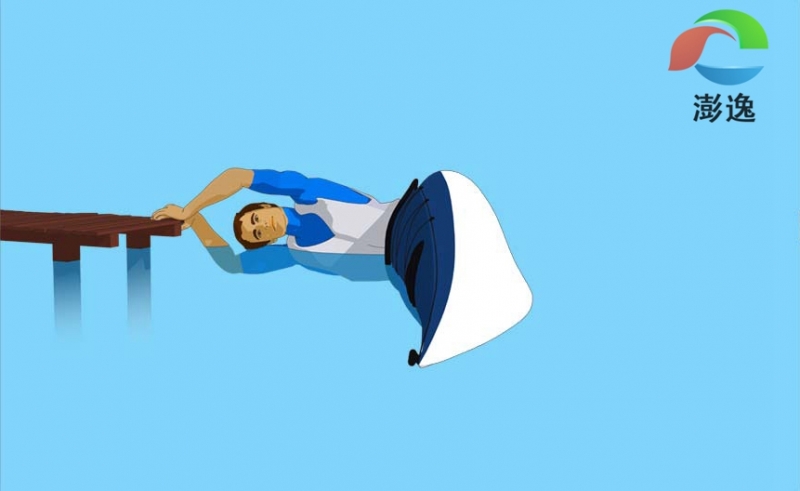 要练习扭胯动作,你需要找到一些你可以在水中握住的固定东西。例如一个码头,一个游泳池的一侧,或者让朋友站在深度到胸部的水中辅助你。当你做扭胯动作时,很重要的是你能用膝盖发力,所以你总是要用脚蹬住脚蹬然后膝盖顶住甲板。 首先,你可以试着做一个扭胯动作,一开始你可以倾斜一点点然后用胯部力量把皮划艇拖回来。渐渐的你可以让自己平躺下去,让皮划艇和身体都侧在水里,用胯部力量把皮划艇反转过来。在练习扭胯的时候,尽量使身体紧贴着后甲板。你可以对比一下,身体垂直的时候反转过来还是比较费力,但是身体贴近后甲板的就很省力就可以反转过来。还需要注意的是,如果你扭跨的动作发力正确并且很快,在某一个点上,你的身体是靠皮划艇自身翻转的力量拉出水面的。多尝试那个点,形成肌肉记忆。这些有助于你在练习支撑和爱斯基摩翻滚的时候获得成功。 To practice the hip flick technique you need to find something steady that you can take a hold on in water. A dock, a side of a swimming pool or a friend standing in chest deep water will be just fine. When doing the hip flick, it is important that you are able to control it precisely with your feet, so always "take a hold" on kayak by pressing your heels down and knees up a bit. First you can try to do the hip flick so that you only "loose your balance" just a little and then pull the kayak back underneath. Then let yourself fall so that your body and the kayak is sideways in water and then flick the kayak back upright. Then eventually you can try to go all the way upside down and do the recovery. While practicing the hip flick, try to keep your upper body as close to the back deck as possible. And for comparison, try to reach your body as far to the side as possible. You will notice that by keeping the body closer to the deck, you need a lot less strength for recovery. Notice also that if you do the flick firm and fast enough, after a certain point your body will start to follow the movement and the rotational energy of the kayak almost pulls your body out of the water. Keeping these things in mind will help you to succeed in the last phases of braces and eskimo roll.  也请记住,当翻艇的时候,水会减慢我们的运动。如果你严重失去平衡,掉进水里无法避免,就不用做其他的动作。失去平衡时,就做好准备,然后尝试用桨将自己恢复平衡。这样落水后你就不会大量消耗你的体力。在失去平衡时,你就要把你的船桨放在一个好的位置,否则你开始尝试把皮划艇翻滚回来的时候,你的船桨还在水里划,身体是借不到船桨提供的支撑力量的。这样在你失去平衡的时候就要做好翻滚准备。 Also keep in mind that when you are falling, the water slows your movement. This means that if you have seriously lost your balance and falling into water can't be prevented, it might be a better idea to first let it happen and only then take the brace from the surface and try to pull yourself back again. This way, majority of your body's movement energy is vanished when you splash into water. After that, you can start the recovery stroke with your paddle in a good position. Otherwise you would be fighting your self into same starting situation, but your paddle would be way under the water. It is also a good idea to try to take the starting position for your recovery stroke while you are falling. This way you are ready to go as soon as you hit the water.  当皮划艇扣在我们身体上人浸水中,很多的人会发生水恐惧,感觉很紧张。因此,第一次练习湿逃脱和爱斯基摩翻滚时,你应该尽量使自己感觉舒适。另外有一个助手在你出错的时候帮你一下是非常不错的。开始练习的时候最好的地方是游泳池。因为游泳池没有浪,水的温度也会合适。如果没有泳池,其他的平静的并且足够深的水域也可以。浮桨包也可以提供很大的帮助,使用浮桨包可以给你很大的浮力让你翻滚,可以调整胯部和其他的身体上的动作。例如你可以用浮桨包检查自己爱斯基摩翻滚的各个阶段的动作是不是标准,但是使用浮桨包会使你的划桨动作不标准。所以使用浮桨包只能适合开始阶段的练习。泳镜和鼻夹也可以帮助你在水里保持冷静,集中注意力。如果你没有看过前面的安全与救援的章节,要先仔细阅读以下安全与救援的章节,然后在继续学下去。 The fear of being in a kayak head under the water can be quite intimidating. Therefore you should try to make yourself as comfortable as possible when practicing braces and eskimo rolls for the first time. It is a good idea to have someone that can help you if something goes wrong. A best place to start practising is no doubt the swimming pool since there are no waves and the water is warm and clear. But any calm and deep enough place will do just fine. A paddle float can also offer a great assistance, because it gives you constant support and allows you to fine tune hip flicks or other upper body movements. For example, by using a paddle float, all the phases of eskimo roll can be examined without rush. The paddle float however makes it hard to lear a proper paddle movements, so it is only good for the first drills. A nose clip and goggles are also a good thing to help you stay calm and focus on the essentials. And if you have skipped the chapter Safe kayaking, then read it well first. 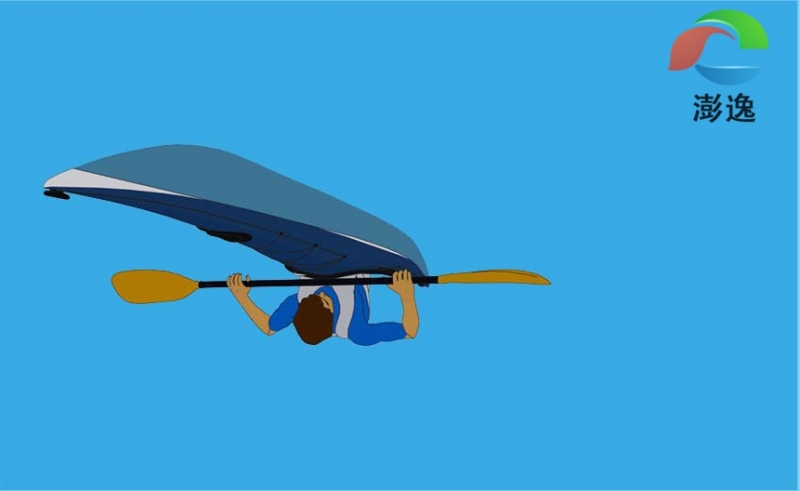
|
 2017-11-13 20:44:08 2017-11-13 20:44:08
|
Post #23
Re: 皮划艇基础教程-澎逸动画演示版 (第一节 码 ... |
 shusheng_100 shusheng_100
|
皮划艇基础教程-澎逸动画演示版 (第十八课 低支撑) 皮划艇运动是国内才兴起的一项运动。是一项新兴起的运动,也是一项古老的运动。在国外蓬勃发展。国内也是渐渐兴起。对于皮划艇的基础知识的普及信息非常少。基于此澎逸收集整理制作了一系列教程。希望可以通过这个让大家更好的掌握皮划艇的技术技巧,享受皮划艇运动的健康快乐。 ----澎逸吴树升(欢迎 转载 注明出处) 低位支撑 Low brace 如果你稍微失去平衡,即将跌倒,低支撑是恢复的方法,甚至不弄湿自己。这里所说的“低”,是指在支撑期间,你的桨要保持在肘部以下。 你可以简单地把桨面推到水面上,或者通过把桨叶在水面上扫过,使支撑时间更长一点。 If you have lost your balance slightly and are about to fall over, the low brace is the way to recover without even getting yourself wet. The prefix "low" here means that you keep your paddle below your elbows during the brace. You can do the low brace by simply pushing the paddle against the surface of water or make it last a little longer by sweeping the blade against the surface. 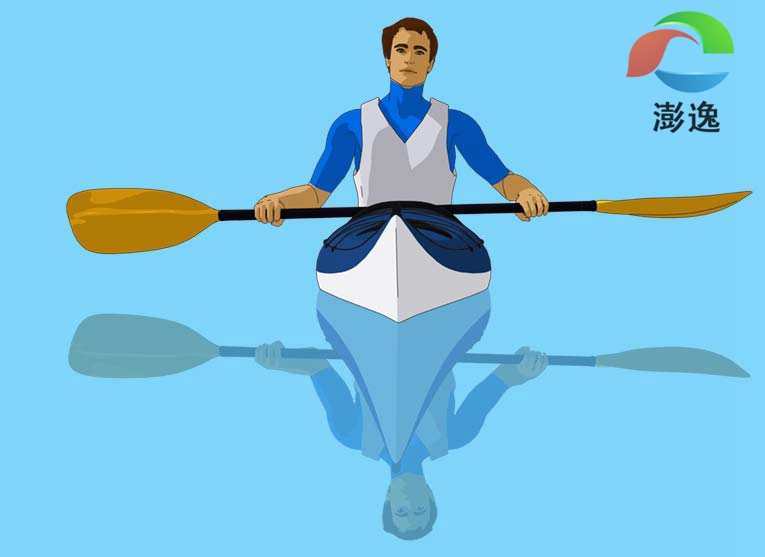 首先,我们将采用正确划桨姿态的握浆姿势。把船桨靠近身体,检查船桨背面是否指向你要倾斜的一侧。这样你的肘部很高,指节垂直船体指向下方。 如果皮划艇在前进,你也需要检查,船桨平面的边缘略向上翘。这样,当你把船桨扫在水面上时,它会压到水面上而不是划入水中。 First we will take the correct posture. Keep the regular forward paddling grip of your paddle. Put the paddle close to your hip and check that the blade's back face is pointing down on the side you are about to lean. This means that you have your elbows on that side quite high and knuckles are pointing downwards. If the kayak would be moving, you would also need to check that the blade's edge that points towards is slightly elevated. This way, when you sweep it against the water, it will start to climb up to the surface instead of diving under the water.  练习低支撑技术,向一侧倾斜直到你开始摔倒。当你稍稍失去平衡后,迅速将船桨叶面推到水面上,借用船桨压水的力量快速的复位。在支撑的时候保持船桨叶片水平,这样你就会得到最好的支撑力。 To practise the low brace technique, lean to the side until you begin to fall over. After you have slightly lost your balance quickly push the blade down against the surface and simultaneously move your weight bravely on the paddle. Try to keep your paddle horizontal while bracing, since that way it will give you the best possible support.  如果在地面上,你的直觉会告诉你你的头部起来带动身体然后让皮划艇恢复平衡,但是在水里,就完全不一样了。是首先恢复皮划艇后,然后带动身体,最后带动头部。 在上一课支撑和翻滚基础上有讲解,正确的动作是扭跨,用膝盖推动甲板,使皮划艇平衡后带动身体恢复平衡。 your intuition might tell you to quickly bend your torso back on top of the kayak to recover the balance. But you are not on a solid ground so things work a little different. First you should righten the kayak and only after that, worry about your upper body. The kayak is rightened by doing the hip flick that was taught in previous tutorial Recovery basics. Basically it means that you twist your hip and push the deck with your knee to make the kayak tilt back upright. 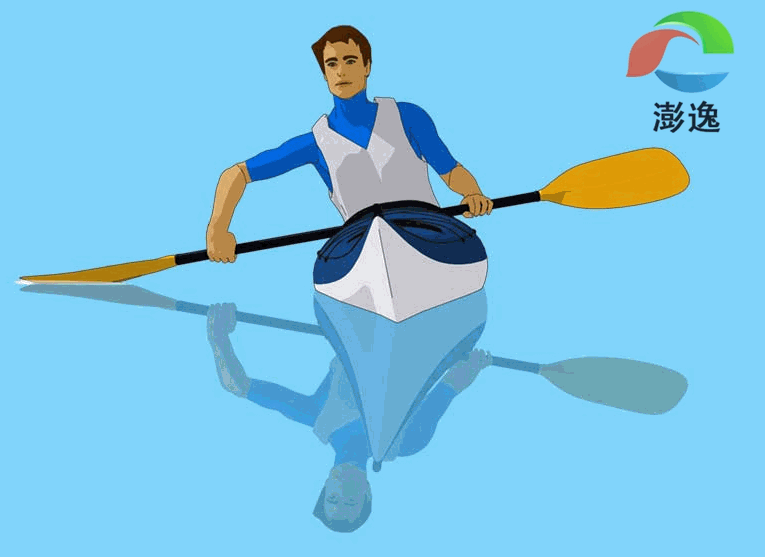 当皮划艇先恢复到水平位置,它的旋转力也会帮助你上半身恢复平衡。想想看!如果皮划艇滑下来,你想把它拉回你的脚下,你身体越贴近甲板就越容易。(这是力学角度的问题) Now the kayak starts to be back to its level position. The rotating force of it will assist you a little, when you push your upper body back to balance. Think of it more as if the kayak would have slipped and you are trying to pull it back underneath you. Keeping your body close to the deck will also make things much easier.  继续练习一段时间后,试着从皮划艇来回运动中做一个全面扫水的动作,这样能支撑更长时间。记住这个需要两边练习。如果倾斜角度太低了低支撑失败,可以尝试用高支撑来找回平衡。(下一课讲解高支撑) Keep practising and after a while, try to add a sweeping motion from back to forth and you will soon be able to brace for a lot longer. And remember to practise on both sides. If the low brace fails, you can try to recover your self by switching to a high brace. 
|
 2017-11-16 11:48:00 2017-11-16 11:48:00
|
Post #25
Re: 皮划艇基础教程-澎逸动画演示版 (第一节 码 ... |
 shusheng_100 shusheng_100
|
皮划艇基础教程-澎逸动画演示版 (第十九课 高位支撑) 皮划艇运动是国内才兴起的一项运动。是一项新兴起的运动,也是一项古老的运动。在国外蓬勃发展。国内也是渐渐兴起。对于皮划艇的基础知识的普及信息非常少。基于此澎逸收集整理制作了一系列教程。希望可以通过这个让大家更好的掌握皮划艇的技术技巧,享受皮划艇运动的健康快乐。 ----澎逸吴树升(欢迎 转载 注明出处) 高位支撑 High brace 如果你失去了平衡,没有时间做低位支撑,船完全倾覆之前你可以做一个高位支撑。高位支撑和低位支撑一样可以有很多种完成方式。应用合适的技术取决于你倾斜的多严重,你的挥动船桨的位置在哪里。当你遇到一个测浪可能推翻你的皮划艇的时候,你需要借力保持平衡,高支撑也可以用。 首先我们学会简单的拍桨面的支撑,然后在添加一个扫桨的动作使高支撑的时间更长。如果你没有看过前面的17节的基础技术,你可以先看看先掌握用桨的技能。高支撑的名字有点误导,做高支撑的时候也向做低位支撑一样尽量使手低位置贴近水面。练习高支撑会可能造成皮划艇倾覆,做好湿身准备。(皮划艇三级技术中,要求人平躺水面,防水裙的船舷边入水后支撑5-10秒钟) If you have lost your balance big time and you don't have the time to perform a low brace, the next step before eskimo roll is to do a high brace. Just like a low brace, a high brace can be done in great variety of ways. The technique that suits you best depends on how badly you have fallen and in what starting position you are. The high brace can also be applied when you need to lean against a big wave that tries to push you over. First we will learn to do the high brace by using a simple draw/sweep stroke and then add a sculling to make the brace last longer. But if you haven't yet read the chapter Recovery basics then back you go. You will need to master those skills first. The name "high brace" is a bit misleading, since just like when doing the low brace, you should try to keep your hands as low as possible and the paddle as horizontal as possible. Be prepared for numerous wet exits while practising. 图片1 开始练习高支撑时候,按照划艇的标准拿船桨,尽量让船桨贴近身体。这里需要注意,用脚蹬住脚蹬,膝盖顶住甲板。这样你倾斜倒在一侧的时候人不会脱离皮划艇 For beginning, keep the regular forward paddling grip of your paddle and keep the paddle close to your body. Note that you should be able to control the kayak precisely with your feet, so make sure that your knees touch the deck and heels are firmly against the bottom. This will also prevent you from falling out of the kayak while you are sideways in water. 图片2 向一边倾斜到倒在水中,你的上半身稍微转一下身体背部向着水平面。人半躺在水中,这样你可以用你的船桨做最大范围的扫桨获得最大的支撑力量。 当你上半身不动倾斜倒在水里的时候,把船桨保持在水面上,这样船桨扫水产生的力就会支撑你起来,而不是减缓坠落。也要保持船桨向着水面旋转一点角度持续扫动。 Lean to the side until you start to fall. Wind your upper body slightly so that you will turn your back a bit towards the surface. Winding your upper body this way allows you to use it later as a main force for the brace and also makes it possible to do a bigger sweep with your paddle. Keep your paddle above the water. Wait until you splash against the surface and your upper body loses most of its momentum. This way all the little support that paddle brace can give is used for the recovery part instead of just slowing down the fall. Try also to keep the paddle as horizontal as possible and turn it so that the blade on the side you are falling is power face towards the water. 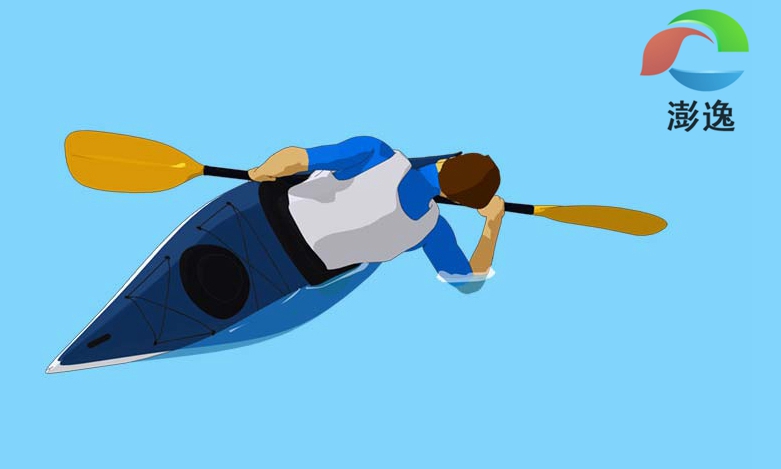 由于你的手和肩膀都是躺在水面上的,在恢复平衡的时候会产生一个巨大的力量,所以你必须尽可能的把船桨靠近你的身体。然后放松上半身,把船桨叶面向下拉,产生一个你可以用的支撑力。因为拉动船桨的幅度不大,持续时间也不长,所以这个动作要快,借助这个力量马上翻起来恢复平衡 Since your hands and shoulders could be exposed to a heavy pressure in quite unusual positions, it is necessary to keep them as close to your body as possible. Start to unwind your upper body and pull the blade down against the surface. This will create a supporting force you can lean against. But since it is not going to last forever, you need to do the following steps quite fast.  当你的上半身沉入水中时有浮力,因此不需要你的桨撑力有多大。你的上半身在水中保持拉桨扫水,这样皮划艇会一直侧立在水中。用你的膝盖和你的胯部推动皮划艇恢复平衡。 When your upper body is half sunken into water, it is also lighter and therefore doesn't need so much support from your paddle brace. Now it is a good moment to straighten the kayak first. Keep your upper body in water and keep pulling the paddle against the water. Do the flick with your hips to push the kayak back upright. 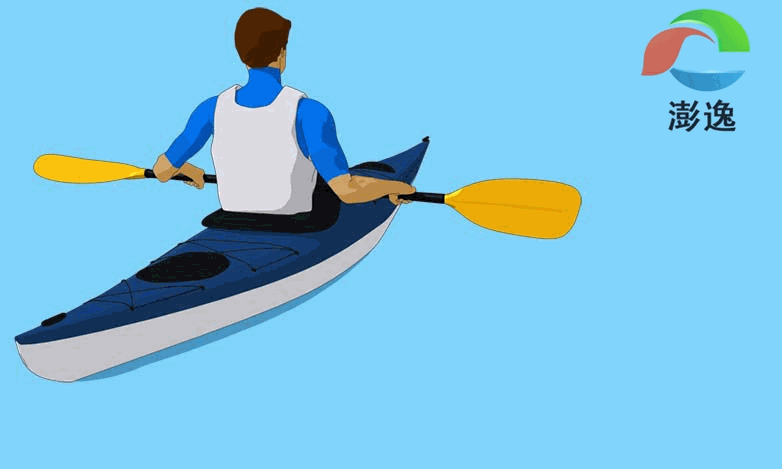 皮划艇恢复平衡后,在将船桨迅速下划让你的上半身露出水面。这里在想想,更想是你把皮划艇拖回你的下面,而不是把自己推到皮划艇上。头部是最后离开水面的。如果可能的话你的身体越接近皮划艇甲板用力就越小。所以身体倾向甲板是很好的动作。 After the kayak starts to righten, pull your upper body out of the water quickly and keep pressing the paddle down. Again, think of it more as if you were pulling the kayak back underneath you, rather than pushing yourself back over the kayak. Your head should come out of the water last. Since the operation is lighter if you can keep your body close to the kayaks centre, it is a good idea to lean towards the back deck if possible.  有时候船桨向下划水的支撑时间很短。 如果支撑力消失,船桨叶片开始在水下下沉。你应该马上旋转桨叶叶片垂直切出水面,船桨到水面后,让船桨保持一个上升的角度快速扫桨。这个技术和摇橹平移相同的。这样本来会翻船的就会恢复到躺倒的时候。然后你可以继续做高支撑的动作。(这个动作是摇橹支撑) Sometimes the paddle stroke does not give you a brace that lasts long enough. What happens is that the support vanishes and the blade starts to sink under the water. Then you should quickly bring the blade up to surface by slicing the blade through water. After the blade is back to surface, start to sweep it horizontally back and forth against the surface and remember to keep the blade in a rising angle towards its direction. The principle of this technique is very much the same as when doing the sculling draw that is taught in chapter Moving sideways. Leaning towards the stern will make things easier. And if everything is done properly, you could continue sculling for as long as you like. 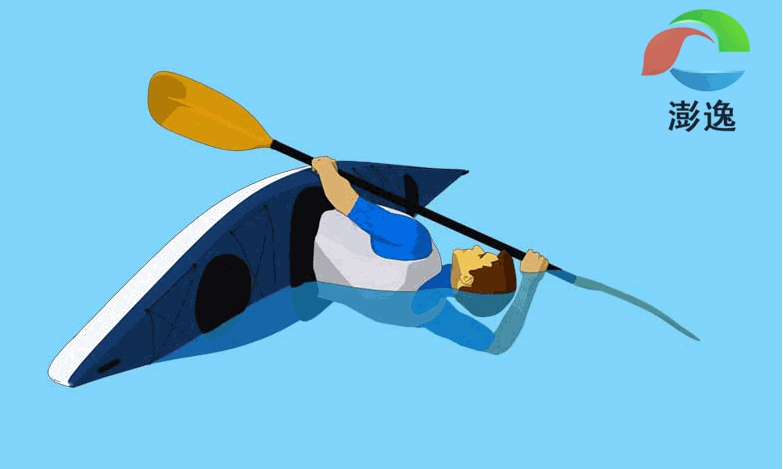 持续练习,直到你掌握了左右两边的高位支撑。高支撑也是爱斯基摩翻滚的重要组成部分,会了高位支撑和摇橹支撑,学习爱斯基摩翻滚也会简单很多。 Keep practising and fooling until you master the high brace well enough on both sides. High brace is also a big part of doing an eskimo roll, so learning it next should not be too hard.  
|
 2017-11-29 10:51:36 2017-11-29 10:51:36
|
Post #26
Re: 皮划艇基础教程-澎逸动画演示版 (第一节 码 ... |
 shusheng_100 shusheng_100
|
皮划艇基础教程-澎逸动画演示版 (第二十课 爱斯基摩翻滚) 皮划艇运动是国内才兴起的一项运动。是一项新兴起的运动,也是一项古老的运动。在国外蓬勃发展。国内也是渐渐兴起。对于皮划艇的基础知识的普及信息非常少。基于此澎逸收集整理制作了一系列教程。希望可以通过这个让大家更好的掌握皮划艇的技术技巧,享受皮划艇运动的健康快乐。 ----澎逸吴树升(欢迎 转载 注明出处) 怎么做爱斯基摩翻滚 How to do eskimo roll 如果翻船的话,爱斯基摩翻滚是最好的和最安全的复位方法。此方法复位迅速,你不用跳出座舱,再想办法倒出舱里的水坐回去。 爱斯基摩翻滚是基于“失位复位基础”章节里教过的相同原理。因此你应该先通读那一章节。在那里,你应该读到安全和练习方面的贴士。 有数十种爱斯基摩翻滚的方法,幸运的是,你只需要掌握一种或两种,在开阔水域,一种方法就足够了。后面要教给你的也许是最常用和最简单的方法。 请注意,在这里学翻滚可以非常容易,但真正在现实中的做到完全是另一码事。所以请一定多多练习。 Eskimo roll is the best and safest technique to recover yourself if you ever happen to capsize. It is fast and you don't have to hop out of your kayak into cold water and figure out how to empty it and get back in. Eskimo roll technique is based on the same principles that are taught in the chapter Braces and rolling basics. Therefore you should read it first throughout. From there, you will find tips on safety matters and practising. There are tens of different kinds of ways to perform an eskimo roll. Fortunately you only need to master one or two. For an open water paddler, one is often enough. The style we are about to learn is probably the most commonly taught and one of the easiest. Remember that learning to roll can be quite easy but doing it in real life situation is different. So keep practising regularly. 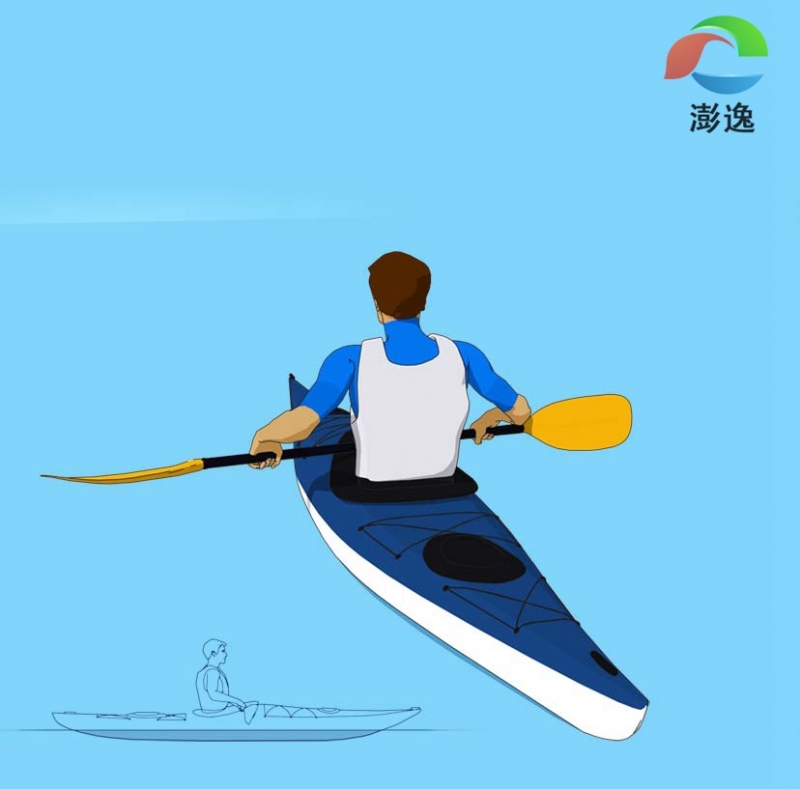 第一次练习的时候,在翻滚前摆好你的起始姿势要容易得多。在现实中,如果在你翻落入水之前,迅速地做好起始姿势,后续动作就易如反掌。这样你就不用在水下想办法费力的将船桨移到右侧。 When practising first time, it is easier to take the starting position for the roll before capsizing. But also in real life, if you are fast enough to get to the starting position before you fall under the water, it makes things a lot easier. This way you don't have to spend time and oxygen while trying to figure out how to move the paddle to right position under the water. 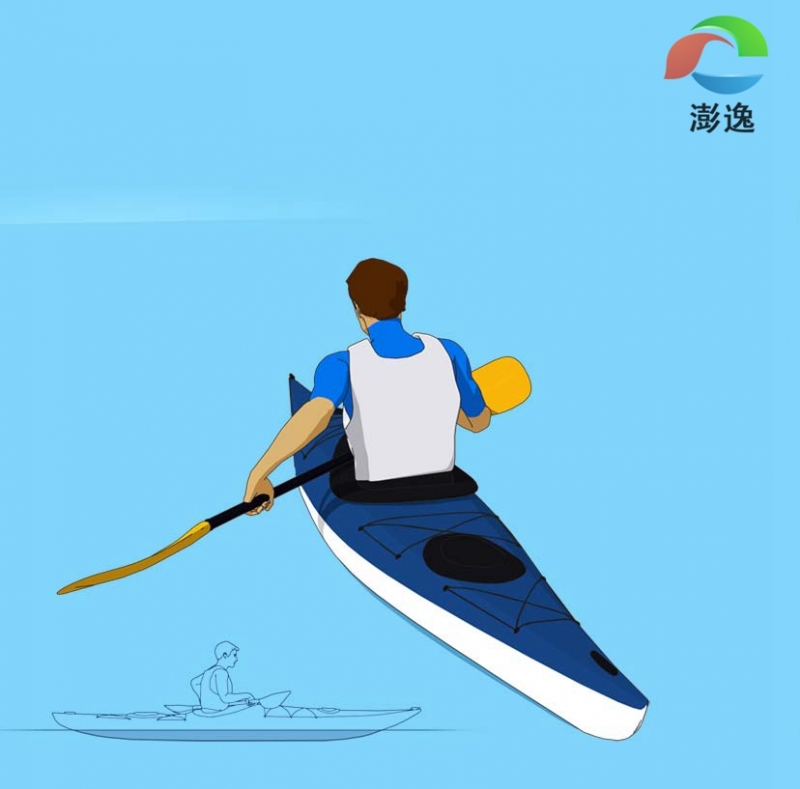 正常握桨,转动上身,使桨位于独木舟左侧。保持右桨面朝上,并使靠近独木舟的桨边缘略为升高,这点很重要。这意味这当你翻入水下,开始划桨的时候,桨面会给你提供一个升力,而不是钻入水下。 低头弯腰,使上身紧贴前甲板,保持右臂几乎伸直。将船桨尽力往前,往下摆放。身体坐稳,也就是你的双膝顶住上甲板,脚跟抵住船底。这样可避免翻滚时你从座舱掉出来。 Grip the paddle normally. Rotate your upper body and place the paddle on the kayak's left side. It is very important to check that the right blade is power face up and so that the edge closer to the kayak is elevated. This means that after you have capsized and start to do the sweep, the blade will create a lifting force instead of diving under the surface. Lean forward towards the deck and keep your head down. Keep your right arm almost straight and place the paddle as forward and down as possible. Sit firmly, meaning that your knees touch the deck and heels are against the bottom. This will prevent you from falling out of the kayak during the roll. 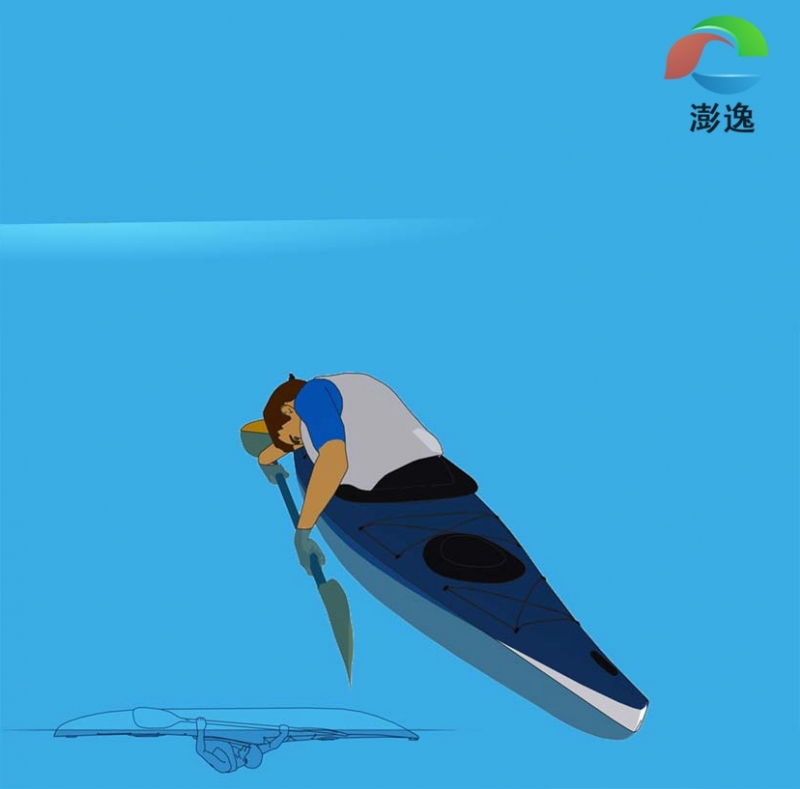 身体左倾,开始翻滚入水。现在你已经翻入水下,你需要控制整个局面。尝试适应这个情况并保持镇静, 因为爱斯基摩翻滚失败的最主要原因就是惊慌失措。一个能帮到你的办法,就是想办法形成一个适合你的固定动作模式。每次都按这个模式做。这样你会觉得有信心,感到全部都在掌控之中。 假定你已经处于一个正确的起始姿势,进一步往前倾,使鼻子贴近甲板。这样当你开始翻转时,你已经很贴近水面。把船桨再往前伸少许,并使其略为离开独木舟,注意检查此时你的双手都在水面之上。 同时,检查你的有桨面是否角度正确,方法是用右桨面轻拍水,或者用手摸一下桨面边缘,感觉它的位置。你有足够的时间做至少两次翻滚,因此,准备工作不要马虎。 Lean slightly to the left and you will capsize. Now that you are upside down under the water, you need to get a hold on the situation. Try to orientate and stay calm, since panicking is usually the fundamental reason behind failed eskimo rolls. One thing that can help is to try to develop yourself a certain pattern you always follow. It's like convincing yourself that everything is in control. You probably already are roughly in a right starting position. Lean more forward and push your nose towards the deck. This way you will be already near to the surface when you start the roll. Push your paddle just a little bit more forward and away from the kayak and check that your both hands are above the surface. Check also that the blade infront of you has the edge further from the kayak elevated. You can do this by slapping it to the surface or by simply grabbing the blade with your hand and feel how it is oriented. You will have plenty of time for at least two good rolling attempts so don't rush with the setup.  现在,我们已经准备好了,即将开始翻滚。复位的基本原理是让船桨由船头至船尾划一个大弧线。这样会提供足够的力量先将船摆正,然后使你的上身露出水面。 保持双手姿势,开始用力划桨,并借力伸直上身。划水时,确保桨面角度正确。这样,你会很快转到右侧水面之下。 Now we are ready to start the roll. The basic idea of the recovery is to sweep the paddle against the water surface in a big arc from the bow to the stern. This will give enough support to first righten the kayak and eventually get your upper body out of the water. Your upper body is strong so use it to do the stroke. Keep your hands in a fixed posture and begin the stroke by starting to straighten your upper body. Make sure that the blade will stay in a right "climbing" angle while you do the sweep. This will create a lifting force and you will soon be floating sideways right under the surface. 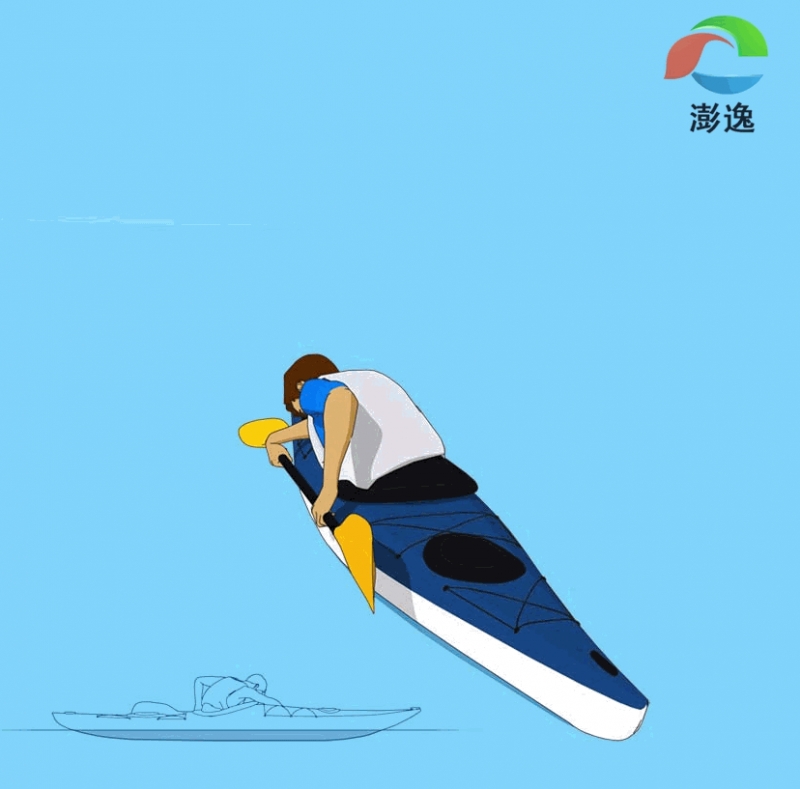 让你的身体做直扫,你首先要做的是让皮划艇复位。保持你的上半身和头部靠近水面,但是不要抬出水面。用膝盖顶着甲板,扭动腰部,做胯部动作翻转皮划艇。 Keep doing the sweep by straightening your body. Your first task is to get the kayak rightened. Keep your upper body and head close to the surface but do not lift them out of water. Straighten the kayak by doing the hip flick; twist your waist and push the kayak's deck with your right knee.  现在,独木舟已经几乎翻转过来,是时间让你的上身翻转到独木舟之上。继续划水,并使上身往后甲板方向倾斜。希望你屁股扭得足够快,独木舟的翻转运动会助你成功。 贴士:有些海洋舟的仓口围板有些高,上身往后靠的时候会比较困难,这时,可将PP抬起一点点,但你不要滑出座舱。 Now that the kayak is almost straightened, it is time to also get your upper body on top of the kayak. Continue the stroke and lean towards the rear deck. Hopefully you have done the hip flick fast enough and the rotating movement of the kayak will help you to succeed. TIP: –The cockpit coaming in some sea kayak models can be quite high, so that leaning back becomes quite difficult. In this case you can let your bottom raise slightly up from the seat, but beware that you don't slip out of the kayak. 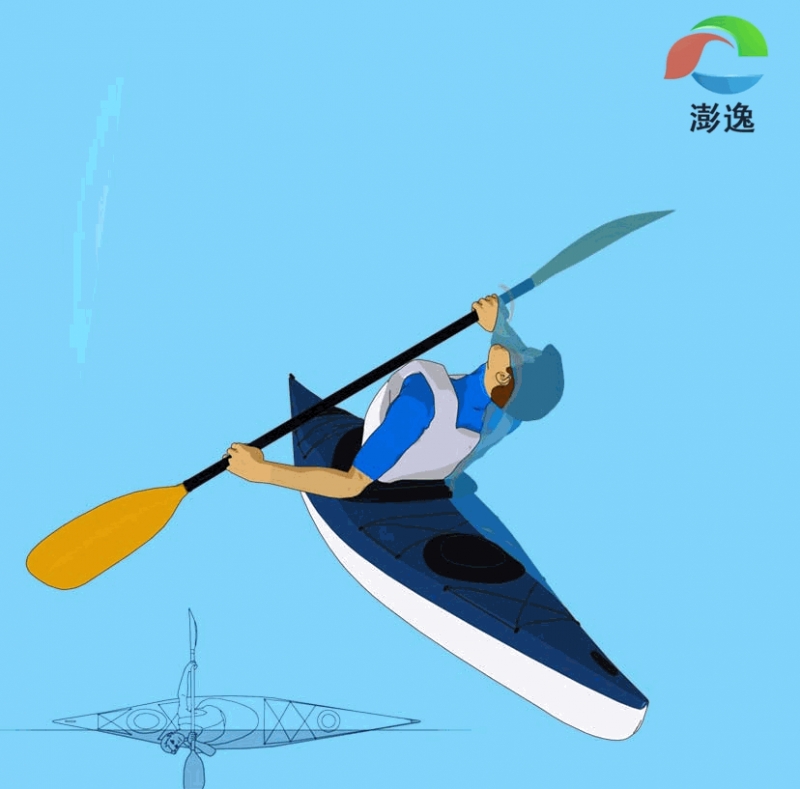 在翻滚临近结束时,向船尾方向的划水动作可能会变得困难。这时,将桨面向下压,并试着滑动身体下的独木舟。如果桨叶下沉太早,可以向船头方向划动,但记住保持桨叶在一个上升的角度。最后身体复位,设法取得平衡。 At the end of the roll, it may seem difficult to continue the stroke towards the stern. Push the blade down and try to slide the kayak under your upper body. If the paddle starts to sink too early, start to push the blade towards the bow. But remember to keep the blade in a rising angle. Finally recover your self and try to regain your balance. 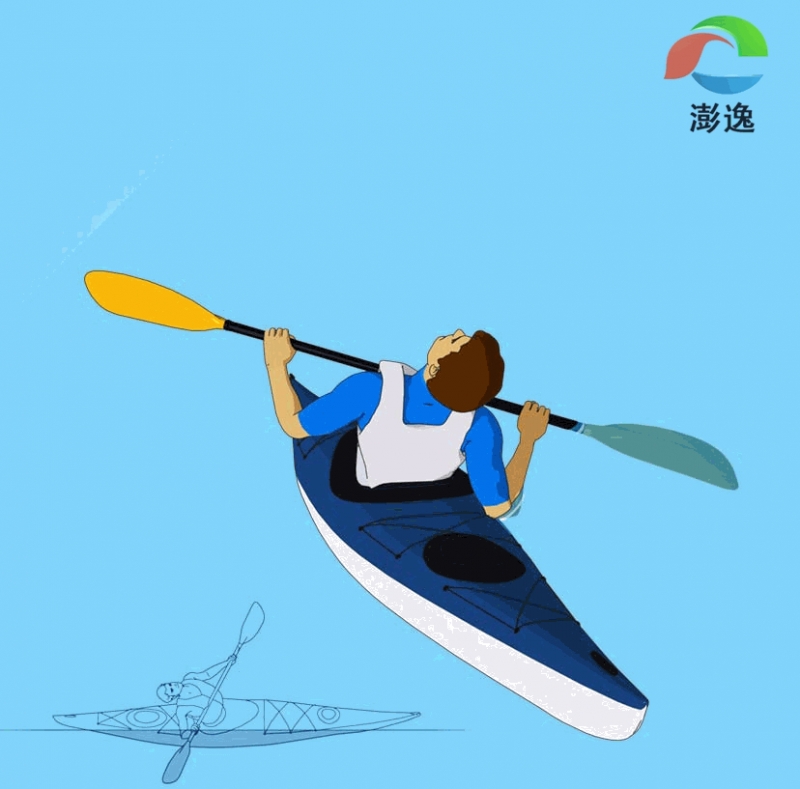 那么,如果中途失败怎么办?如果你觉得失败了,放弃! 设法将头露出水面,呼吸!准备再次练习。从起始(预备)姿势开始。 如果练习过程中你觉得差得很远,你可以在水中举起手,让手露出水面摇动,你的朋友可以过来帮助你。你可以做一个所谓的“有帮助的爱斯基摩自救”,方法是你朋友将船头靠在你身边,然后你抓住船头,完成动作。 如果在水下呼吸困难,唯一的选择,滑出座舱,浮出水面。 贴士:寻找失败的原因有时会很困难,要注意的是,保持桨面在一个正确的角度,在座舱里坐牢,不要过早地将头升出水面。 And what to do if it fails? When you feel that your rolling attempt is not going to succeed, give up and try to get your head above the surface. This way you can at least get some air, so that you will have more time to perform another try. And try to get yourself to the starting position before you start to fall down again. If you feel that your attempts are not even close, you can try to call help by raising your arms above the surface and waving them. This way, if one of your friends is fast enough, you can use a tecnhique called assisted eskimo rescue. It means that your friend brings the bow of his kayak next to you and you pull yourself up. If the air starts running out, your only option is to pull off your spray skirt and hop out. TIP: – Tracking the reason for failure can be difficult. Focus on keeping the blade in a right angle, sit firmly and don't lift your head above the surface too early. 
|
邀请xuliang1215参加此活动